#bonded aggregate
Explore tagged Tumblr posts
Text
Mediterranean Landscape

This is an illustration of a medium-sized, fully-shaded backyard in the Mediterranean with a fire pit.
0 notes
Photo

Sussex Gravel Design ideas for a mid-sized mediterranean partial sun backyard gravel landscaping with a fire pit in summer.
0 notes
Photo

Fountain - Farmhouse Landscape Photo of a large farmhouse backyard stone water fountain landscape.
0 notes
Text
Some Worldbuilding Vocabulary

Abeyance: When the audience temporarily suspends their questions about made-up words or worldbuilding details with the implicit understanding that they will be answered later in the story.
Absorption: The two-way street wherein the audience is immersed in the created world and is picking up the author’s metaphoric building blocks to recreate the concept in their head.
Acculturation: When an adult assimilates into another culture.
Additive: When something has been added to a secondary world, usually in the form of magic or fantasy species.
Affinity: A kinship pattern wherein the familial bond is based upon marriage.
Aggregate Inconsistencies: When audiences pick up internal inconsistencies not within the same story but from multiple sources within the shared universe.
Anachronism: Details that do not conform to their time period or culture.
Analogue Culture: Real-life cultures that the creator emulates in their work and then applies their fantasy conceits to.
Ancestor Worship: The belief that deceased ancestors still exist, are still a part of the family, and can intervene within the living world on their descendants’ behalf.
Animism: The belief that all objects, creatures, and places are imbued with a spiritual essence.
Apex Predator: The predator at the top of a food web that no other creature naturally feeds upon. Two apex predators cannot exist in the same niche.
Apologetics: In worldbuilding, the attempt to explain inconsistencies in terms of existing canon.
Appropriated Culture: Using a culture as a whole that the creator is not a member of. Different from an analogue culture in that the analogue is changed by the creator and used respectfully.
Artifacts: In worldbuilding, the observable ways a culture behaves due to their cultural worldview. This can include politics, economics, religion, education, arts, humanities, and linguistics, along with many other cultural norms.
Ascendant: In worldbuilding, a world that the magic is increasing in power and influence.
Assimilation: When an individual rejects their original culture and adopts the cultural norms and beliefs of the dominant culture.
Author Authority: When an author demonstrates expert-level knowledge in a field to their audience.
Author Worldview: What Mark J. P. Wolf calls “not only the ideas and ideologies of the world’s inhabitants, but also those which the author is expressing through the world’s structure of events.”
Autocracy: A government in which supreme power concentrates in the hands of one individual or polity.
Avatar: The embodiment of a deity in another form, usually humanoid.
B-C
Bible: In the field of television writing, a series guidebook that usually includes the pitch, character descriptions, a synopsis, as well as worldbuilding details.
Biome: The vegetation and animals that exists within a region. Terrestrial biomes include: forest (tropical, temperate, or boreal), grassland, desert, and tundra.
Black Box: In information processing, when a system is viewed in terms of its inputs and outputs without any understanding as to its internal workings.
Bottom-Up: In design, where the granular, base elements of the system are created first, then grouping them together into larger constructs over and over until a pattern forms. Also known as “pantsing” in writing and worldbuilding because the creator is building by the seat of their pants.
Callback: From standup comedy where the punchline in a joke used earlier in the set is alluded to again, eliciting another laugh from the reframing of what was already familiar.
Canon: The core doctrine for the world when conflicting information arises. Usually what the original creator made takes canonical precedence over subsequent additions.
Capitalism: The economic system wherein individuals own the means of production.
Chekhov's Gun: Often understood to mean that something must be introduced previously if it will have significance later in a narrative, but meant by the playwright that nothing should be included in the story that is not completely necessary.
Climate: The temperature and rainfall in regions over approximately 30 years. Classified as tropical (high temperature and high precipitation), dry (high temperature and low precipitation), temperate (mid temperature and mid precipitation), continental (in the center of large continents with warm summers and cold winters), and polar (low temperatures and low precipitation).
Commercial Fiction: The style of fiction that includes all genre fiction, the aim of which is entertainment. Often fast-paced and plot-driven.
Compelling: One of the four Cs of worldbuilding, which deals with how well the core concept and subsequent details maintain audience interest.
Complete: One of the four Cs of worldbuilding, which deals with the sense that the world is lived in, has a sense of history, and continues on even when the story ends.
Complexity Creep: When material gradually grows in complexity over its lifetime, raising the bar of entry for new people experiencing the material for the first time.
Conceits: Where a story deviates from reality. Usually the focus of the fiction by being what the author intends on exploring in their works.
Conlanguage: A constructed language created specifically for a story world.
Consanguinity: A kinship pattern wherein the familial bond is based upon a shared genetic lineage.
Consistent: One of the four Cs of worldbuilding, which deals with how well the material maintains its own internal logic as established by the fantasy conceits.
Constructed World: A fictional world that does not exist but was created by someone.
Continuity: A gestalt term for perception where the mind fills in obvious blanks to make a unified whole.
Convergent Evolution: When two or more species develop analogous features to deal with their environment.
Co-Residency: A kinship pattern wherein the familial bond is based upon shared space.
Cosmology: The study of mapping the universe and our place in it.
Cost: In worldbuilding, when a character must risk or sacrifice something for magic to take effect.
Creative: One of the four Cs of worldbuilding, which deals with how and to what extent the constructed world deviates from the real world.
Credibility Threshold: Where worldbuilding details must only appear plausible to a general audience rather than demonstrating expert-level knowledge.
Cultural Identity: An individual’s self-concept as distinct from others based upon nationality, ethnicity, social class, generation, and locality.
Cultural Universals: Traits, patterns, and institutions prevalent throughout humankind.
Customs: Informal rules of behavior that people take part in without thinking about it.
D-F
Deity: The most powerful of metaphysical entities, deities often exist in pantheons, have thematic powers based upon their roles, and few weaknesses or limitations.
Descendent: In terms of magic, the idea that the most powerful magics are from ages past and that magic is on the decline in terms of power and influence.
Despotism: An economic system wherein an individual or institution controls the laws and resources of an area.
Deus Ex Machina: A plot device in which an unexpected power, event, or deity intervenes to save a hopeless situation.
Differentiation: When one culture forms part of their identity by contrasting themselves with another nearby culture.
Divergent: When the creator alters something in the development of the world but it remains very similar to the real world in every detail but this fantasy conceit. For instance, a world that resembles our own but made up of anthropomorphic animals instead of humans.
Divine: The belief that something is of, from, or like a god.
Democracy: A government in which the people elect a governing body in some fashion.
Early Adoption: When an inventor or culture creates a technology long before their analogue culture did in the real world.
Easter Egg: A hidden message, image, or feature that is meant to be hunted for within the material.
Economics: The study of production, distribution, and consumption of goods and services.
Education: A form of socialization in which we teach the youth what they need to know to become functioning members of society.
Effective Worldbuilding: When (a) the immersive state is never disrupted for the audience, or when (b) the immersive state is disrupted with a positive result.
Element X: N. K. Jemisin’s concept of when fantasy elements diverge from the real world. Similar to fantasy conceits.
Emic: An account of a cultural idea, concept, behavior, or belief documented as if from within the culture.
Empires: Multinational states with political hegemony over other ethnicities, cultures, or nations.
Encyclopedic Impulse: The consumer’s desire to know everything about the world or the author’s desire to expound upon all the worldbuilding details.
Ephemera: Transitionary materials that are not meant to exist for long term, such as advertisements, diary entries, letters, posters, and the like.
Ethnicity: A group that identifies with each other based on presumed similarities such as a shared language, ancestry, history, society, or social treatment within an area. Ethnicities are not dependent upon, but are often associated with, certain taxonomic traits or physiological similarities within those groups.
Etic: When cultural ideas, concepts, behaviors, or beliefs are documented from outside the cultural milieu as a passive observer with an eye for similarities between all cultures
Exsecting: When the creator removes something that exists in the real world from the created world.
Extrapolation: In worldbuilding, the belief that any fantasy conceit should be followed to its natural conclusion.
Face Validity: When worldbuilding detail appears believable upon immediate examination. See Credibility Threshold.
Fan Service: Material included in a story that serves no narrative purpose other than to please fans.
Fantasy Conceit: What the creator intends to explore in the world, it is where the constructed world deviates from the real world, usually in the form of geography, biology, physics, metaphysics, technology, or culture.
Fantasy Function: When analogue cultures are filtered through fantasy conceits to populate the created world with its output details.
Fetishes: Items imbued with cultural significance and power.
First Principles: Core belief and value systems within a culture that are often unconscious until confronted.
Flavor Text: Texts within stories, video games, role-playing games, and action figures that add depth by providing a sense of history but do not alter the game mechanics or story in a substantial way.
Feudalism: An economic system wherein there is a division between the lords that protect the vassals that work the land in exchange for protection.
Four Cs of Worldbuilding: See Creative, Complete, Consistent, and Compelling.
G-L
Gender: A social construct of how cultures differentiate the sexes.
Generalist: When every individual in a society has the same basic job, which is providing their daily caloric intake. A staple of hunter and gatherers and in contrast to specialists.
Generation: A social cohort group based around the period in which children grow up, become adults, and bear children of their own. Because of this shared timeframe and significant events in their lives, generations often share a similar worldview within the general culture.
Genre Expectation: The qualities audiences expect of their genres to be considered successful, i.e. is the thriller thrilling or the romance romantic. For fantasy and science fiction, the genre expectation is worldbuilding.
Goldilocks Zone: The habitable zone around a star where the temperature is right for water to exist in liquid form.
Group: Two or more individuals who share a collective sense of unity via interacting with each other because of shared similar characteristics.
Habitat: The ecosystem or ecological community creatures exist in.
Handwave: A writing term for explaining crucial events dismissively with minimal details.
Handwavium: As opposed to the handwave, when everything else in the imagined world fits logically together with the exception of the fantasy conceit, which the audience must then accept to continue on with the story.
Hard Deduction: When there is no narrator and no character bringing the worldbuilding details to the audience’s attention, who must then piece together the world rules based upon the provided details alone.
Hard Impart: When information is imparted to the audience through narrative text, usually through the narrator or the internal thoughts of characters.
Hero Props: Items that are necessary for a scene to take place, making them integral to the story.
Heroic Theory of Invention: When inventors and discoverers of scientific developments are treated as solitary geniuses rather than products of good luck or a part of a team.
High-Concept: A term from the film industry meaning an idea needs lots of background details, usually compiled from the worldbuilding, to be explained for the core concept to be compelling.
Hybrid: (a) In biology, a living thing bred together from two different species, which is not able to produce its own viable offspring. (b) A method the author can employ to get details across to the audience in which it appears they are using a hard or soft impart, but the audience deduces are not correct, which then casts provided information into doubt and adds new nuance.
Iceberg Theory: The theory proffered by Hemingway that so long as the author is aware of the underlying ideas, they can cut away anything from the story and it will still make sense. Usually interpreted to mean one only needs to reveal 10% of worldbuilding details or backstory.
Illusion of Completeness: The sense that the world is complete and that all questions can be answered within it rather than the creator explicitly spelling out all the details.
Immersion: The altered state in which the audience feels they are physically present in a non-physical world.
Ineffective Worldbuilding: When worldbuilding details become obvious to the consumer, thus breaking the sense of immersion and reminding them of the real world. This can be caused by internal inconsistencies or from reality incursions.
Info Dump: A sudden overwhelming quantity of backstory or background information supplied in a short timeframe.
Info Dump Equity: The idea that an author should not reveal worldbuilding information until the audience craves it, thus being able to deliver an info dump without anyone complaining.
In-Group: The other people an individual identifies with. While they may not share the exact worldview, they share the same first principles in understanding the world around them.
Innovation: The drive for change, usually technological, but also socially.
Inside-Out: How audiences process worldbuilding details, in that they pertain to the immediate understanding of the scene, which are then pieced together into an understanding of the world.
Inspired Worldbuilding: The top form of worldbuilding, which invites additional audience interaction via their imagination after the story has concluded.
Institutions: Stable organizations of individuals formed for a shared purpose, usually by performing specific, reoccurring patterns of behavior.
Integration: When an individual adopts the cultural norms and beliefs of the dominant culture while still retaining their original culture.
Interconnection: When the threads of worldbuilding are tied together cohesively. Part of Sanderson’s third law of magic systems.
Interquel: Stories set in an existing world but that do not connect with the original story.
Intraquel: Stories set in an existing world that fill in gaps in the existing story.
Kinship: How social relationships organize into groups, roles, and families. Usually consisting of consanguinity, affinity, or co-residency.
Limitations: Checks put upon magical powers, usually in the form of weaknesses and costs. Sanderson maintains in his second law that limitations are more dramatically important than powers.
Linguistics: The study of languages.
Literary Fiction: The style of fiction that aims for awards, considers itself art, focuses on the prose, and is usually slowly paced.
Locality: The small-scale community in which the individuals in a group grew up, usually comprising of a town, neighborhood, or block, which differentiates them from others in the surrounding area.
M-O
Macroworldbuilding: The first of the stages N. K. Jemisin breaks her worldbuilding process into, which consists of planet, continents, climate, and ecology.
Magic: Change wrought through unnatural means.
Magic Point Systems: Magic systems where the casters have a set amount of energy, usually referred to as mana, to spend on their effects.
Magical Thinking: The belief people can affect change the world around them through thoughts and behaviors.
Mana: A frequent generalized term for the finite resource magic users spend on their magical effects.
Marginalization: When an individual rejects both their original culture and the dominant culture.
Mary Sue/ Marty Sue: Originally a created character for fanfic who has no flaws and is inserted into interactions with the canonical characters. Now an insult leveled at characters consumers don’t like, usually claiming they are overly capable and without flaws.
Masquerade: A term taking from the World of Darkness RPG wherein the existence of magic is hidden from the general populous.
Metaphysics: In worldbuilding, dealing with deities, spirits, cosmology, and the afterlife. In essence, creatures and locations that do not abide by understandings of biology or physics.
Microworldbuilding: The second of the stages N. K. Jemisin breaks her worldbuilding process into, which consists of species, morphology, raciation, acculturation, power, and role.
Monotheism: The belief in a single deity only.
Mystery Box: The theory proffered by JJ Abrams that mystery drives audience interest, which will keep them invested in a story so long as they are promised elucidation later.
Mythopeia: Constructed mythologies, lores, and histories within created worlds.
Nationality: How an individual relates to their state. A component of cultural identity.
Nominal Change: A superficial change in the secondary world that contributes nothing to the worldbuilding.
Norms: What is considered acceptable group behavior and what people should and should not do in their social surroundings.
Oligarchy: A government in which power rests in a small group of people like the nobility, wealthy, or religious leaders.
One-Off: An intentional inconsistency meant to highlight the aberration as separate from the established worldbuilding.
Out-Group: Those that do not share the same collective worldview, which are often mistrusted or viewed with outright hostility.
Overlaid Worlds: Constructed worlds with real-world locations but with the addition of fantasy elements.
P-R
Pantheon: A categorization of collected deities based upon the culture that worships them
Pantsers: Creators who build or write without a clear outcome in mind. See Bottom-Up.
Pidgin Language: A grammatically simplified language used for trade that comprises vocabularies drawn from numerous languages.
Planet of Hats: The trope of treating a species or world as monolithic and with one defining trait.
Planners: Worldbuilders or writers who have a clear plan once they start creating. See Top-Down.
Politics: The decision-making process within groups and individuals involving power structures.
Polytheism: The belief of multiple gods, usually inhabiting a pantheon.
Porcelain Argument: In worldbuilding, the belief that technology stagnates at the level at which magic or a fantasy conceit is introduced.
Portal Fantasy: A subgenre in which the characters from the real world travel to a secondary world.
Prequel: Stories set in an existing world that precede the original story. They do not need to connect to the original story but often do.
Primary Sexual Characteristics: The sex organs used in reproduction.
Primary World: The real world in which we all reside and draw our experience from.
Prime Mover: A conceit that cannot be removed without the story world falling apart.
Profane: Something that is religiously blasphemous or obscene.
Prologue: An opening sequence in a narrative that establishes background details to create context, clarification, and miscellaneous information for the audience
Promise of the Premise: The term coined by Blake Snyder for the point in the story when the setup is complete and it examines its core conceits. An author breaks the promise of the premise when the story is not about the promised core concepts.
Pull Factors: Factors that draw immigrants to an area.
Purple Prose: Descriptions that becomes overly ornate and extravagant, to the point they break the sense of immersion by drawing attention to themselves.
Push Factors: Factors that drive immigrants out of an area.
Race: (a) In biology, a grouping of populations below the level of subspecies, and is rather imprecise in distinguishing the differences between them. (b) In the fantasy genre, usually understood to mean “species.”
Racial Attributes: The assumption that any one fantasy race shares not only certain abilities like flight or the capacity to speak with animals, but certain demeanors, temperaments, and biases.
Reality Incursions: When the outside world interjects itself into the created fantasy experience to remind the consumer that this is indeed a made-up world. They usually occur when the consumer has expert knowledge in a field that is not depicted correctly in the narrative.
Reciprocity: When people respond to actions with similar actions. This can be positive, as in the exchanging of gifts, or negative, as with punitive eye-for-an-eye punishments for crimes.
Relativism: The belief there is no real objective universal truth and that we base all understanding upon perception and consideration.
Religion: The cultural system of behaviors, morals, ethics, and worldview in which humans deal with supernatural, metaphysical, and spiritual conceptions.
Retcon: Short for “retroactive continuity,” the term comes from comic books when previous canon or facts are ignored or contradicted so as to assimilate new stories or understandings in current storylines.
Reverberations and Repercussions: The understanding that any change within a world creates many expected and unexpected changes to the whole.
Rituals: Formal customs often involving gestures, words, and objects performed in a traditional sequence.
Rule of Cool: The understanding that the audience’s willing suspension of disbelief for a given element is directly proportional to its level of “coolness.”
Rule of Law: The idea that laws extend to the lawmakers as well as the general populous.
Rule of Three: In worldbuilding, the concept coined by Randy Ellefson in which an author should alter at least three components of a trope to make it their own.
S
Saturation: Mark J. P. Wolf’s term for when there are simply too many details for the audience to fully absorb, which he maintains makes the world stronger since it invites the audience to reexperience the material again and again to glean something new each time.
Scarcity: When people put higher value on rare things and assign lesser value to things in abundance.
Secondary Sexual Characteristics: The distinguishing traits that distinguish the sexes, such as human males’ facial hair or females’ breasts.
Secondary World: A created world that does not exist.
Selection: In biology, the preferential survival and reproduction or elimination of individuals with certain traits. Can be either artificial, natural, positive, or negative.
Separation: When an individual rejects the dominant culture in favor of preserving their original culture, which often leads to minority enclaves within the dominant culture
Sequel: Stories set in an existing world that follow the original story. They do not need to connect to the original story but often do.
Set Piece: An iconic scene that exemplifies the story even though it might not actually be necessary to the story itself.
Shamanism: The belief that specific individuals have access to and influence over the spiritual realm, usually derived by ritual and entering altered states.
Show Don't Tell: The understanding that the audience prefers to experience the worldbuilding details and storytelling events in action rather than having them explained.
Smeerp: Unnecessarily renaming something to make it seem exotic. Derived from James Blish’s sarcastic use of the term when describing rabbits.
Smeerp Hole: When one seemingly minor change contributes to a whole slew of other changes on the author’s part that add little to the audience experience as a whole.
Social Class: The hierarchal social stratification of groups, usually manifesting as upper, middle, and lower classes.
Socialism: The economic system in which the workers or government own and manage the means of production.
Socialization: The process in which a group passes on the worldviews, norms, and customs to their children.
Soft Deduction: When a character with knowledge of the worldbuilding takes action based upon specific information to get the worldbuilding rules across to the audience.
Soft Impart: Information presented to the audience not through narrative text but through a trustworthy side character or source. Can often come about from an overheard conversation or explanation from another character.
Specialization: The divisions of labor and creation of occupations when the population does not individually have to account for their daily caloric intake. As opposed to generalist.
Species: A group of living creatures capable of exchanging genetic material and producing viable offspring.
Speculative Fiction: An umbrella term for fiction that inject elements into the story that do not exist in the real world. Fantasy, science fiction, horror, historical fiction, alternative history, and dystopian and utopian fiction are just a few genres that qualify as speculative fiction.
Spotlighted/Lampshaded: A potentially troublesome concept or idea that is intentionally brought to the audience’s attention before it becomes problematic to highlight that it is intended as a fantasy conceit rather than an accidental anachronism.
Stasis: The drive to maintain the current order, be it social, political, or technological.
States: Organized governments overseeing a specific territory that can interact with other states.
Streamlining: Part of Sanderson’s third law of magic in which worldbuilding details should be accounted for by already existing fantasy conceits instead of creating whole new conceits.
Suspension of Disbelief: When an audience makes a choice to suspend their critical faculties to allow for a patently unreal concept to be considered logical for the sake of entertainment.
T-W
Taming: When an animal has been taught to tolerate human presence. As opposed to domestication.
Technobabble: When a character spouts a number of details to establish their expert credentials in the field. Technobabble is not meant to be understood by either the audience or the other characters, only to establish the character’s authority on the subject.
Terra De Facto: The implicit understanding that anything that is not accounted for by a fantasy conceit must therefore abide by the rules of the primary world.
Terrain: The vertical and horizontal proportions of land masses, which includes how high it is above sea level and at what slope.
Theocracy: A government where the religious leaders and practices control the laws in addition to the religious norms and rituals.
Toehold Details: Descriptors that specifically trigger the assumption of an analogue culture and time period, and therefore help the audience to mentally populate the scene.
Top-Down: In design, when the underlying idea or system is formed on a grand scale, then with all subsequent subsystems being added and refined until everything is mapped out. Also referred to as “planner” or “engineer” when it comes to writing or worldbuilding.
Totems: Imbued emblems representing a group of people tied to a specific spirit.
Transmedial: When a story or world exists in multiple mediums.
Tropes: Reoccurring motifs, images, plots, and characterization that exist within a genre.
Unchanged: When the creator does not use a particular fantasy conceit and leaves their created world the same as the real world in regards to this fantasy conceit. See Terra De Facto.
Unobtanium: In engineering, the term used for materials or technologies that do not yet exist but will one day solve current problems. Frequently used in science fiction worldbuilding.
Upmarket Fiction: The style of fiction that aims for creating discussion. It often blends literary and commercial fiction, deals with universal themes, has accessible language, and is character-driven.
Weakness: Limiting factors that diminish the power or the person using it. Part of Sanderson’s second law of magic.
Worldbuilding Capital: Time and mental energy sunk into a world, which is why authors frequently reuse the existing world instead of forming a new one for subsequent stories.
Worldbuilding Kudzu: When too many worldbuilding choke out the pertinent information by sheer volume, thus disrupting immersion.
Worldview: How a society or individual orients their knowledge and point of view towards the world. This includes philosophy, fundamentals, existential postulates, values and ethics, ideology, and attitude. It encompasses the concept of why the world works the way it does and the “correct” way to act within it.
Worship: The act of religious devotion towards a deity or ideal.
Source ⚜ More: Word Lists
#worldbuilding#terminology#writeblr#fantasy#dark academia#writers on tumblr#writing reference#spilled ink#literature#poets on tumblr#writing prompt#poetry#fiction#novel#creative writing#light academia#lit#words#langblr#linguistics#booklr#bookblr#rene magritte#writing resources
161 notes
·
View notes
Text
Five Stages Of Feelings
Neteyam x Na'vi Reader
Summary: the decision to go looking for you was the best decision he ever made
Warning: enemies to lovers, hurt reader


3rd person pov
The village knew of the rivalry between the oldest son of jake sully and the daughter of ninat, they fought for the title of best hunter of their age group but it only ended in punishment.
"This is your fault" yn hissed bumping shoulders with neteyam as she passed him, neteyam growled and grabbed yns wrist pulling her to look at him, his tall figure looming over her.
"Its not my fault you don't know how to shut your mouth" he spat, the two were paired on a hunting trip his father thinking it would be a good 'bonding' experience but the two started bickering scaring off the pray.
"Then you should've giving me a bloody arrow" yn pulled her wrist from him harshly causing her to stumble and fall into the mud the mud splattering over her body, neteyam burst out laughing he bent over clenching his stomach trying to catch his breath.
Yn huffed and got up stumping off into the woods "your going to get us in more trouble" neteyam called after her but when she didn't to back he huffed rolling his eyes and went his own separate way back to the village.
He took a seat at the end of the village watching the trees carefully this is the way you'll be coming back and he just wants to annoy you further but when you didn't arrive at eclipse a feeling started to tug at his heart.
Worry? Guilt? No why would he feel any of those he let out a forced laugh he hates you he wouldn't care if you went missing it would actually be better for him.
He waited for a few minutes and slowly started to pace his eyes still trained towards the forest he slowly became more aggregated with himself "ah fuck it" he cursed loudly and walked into the woods.
His tracking skills helping him very much "your going to be the death of me yn" he grumbled slowly climbing over the roots that was in his path, his ears flickered as he heard it.
A whimper of pain, he crouched low to the ground slowly making his way to the sound his eyes looking around for any predators that might be lurking.
"Yn" he whispered as he caught sight of you laying on the ground his breath caught in his throat as they ran over your body noticing the blood "fuck" he muttered and jumped to your side.
His hands wavered as they hovered over you he didn't know what to do "w-what happened" he choked as he moved his gaze to your eyes his heart clenching as he saw the tears rolling down your face.
"V-viperwolfs" you grunted, neteyam quickly slid his hands under your body trying to pick you up but you cried out in pain "c-cant" you weakly pushed him away as you spoke.
He grabbed your hands holding them tightly "I have to get you back" he said his voice filled with concern but you just shook your head "n-not gonna make it" you cried making him shed a tear of his own as he shook his head.
"I'm not gonna let you die" his voice was dipping as he slowly lifted your hands to his chest "you can't die" he murmured making yn giggle which turned into a coughing fit "starting to sound like you care about me sully" you panted he nodded his head.
"I do surprisingly" he smiled sadly "is it bad I think the same" yn said making neteyam chuckle and shake his head "I think it's perfect" he whispered and leaned down connecting their lips together in a quick kiss before pulling back just leaving a inche between them.
"Neteyam" he hummed in response, yn shifted slightly taking out a fruit that was underneath her, neteyam frowned in confusion intill he saw that the fruits juice had a blood like texture he looked between the fruit and yn making her smile nervously.
"Lo'ak and kiri put me up to it but I'm glad we feel the same way" she giggled slowly sitting up he narrowed his eyes at her growling slightly.
"I'll get you back one way or another"
Tag.List
@laylasbunbunny @neteyamyawne @sweetirilly @greekgods15 @erenjaegerwifee
#avatar#avatar x reader#avatar pandora#avatar way of water#avatar x reader fluff#avatar fluff#neteyam sully#neteyam x reader#neteyam#neteyam fluff#neteyam x reader fluff#avatar pandora fluff#avatar fanfic
599 notes
·
View notes
Text
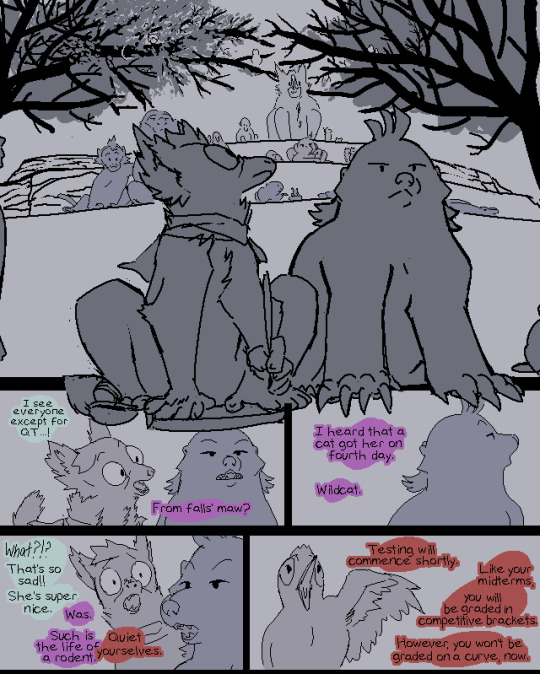
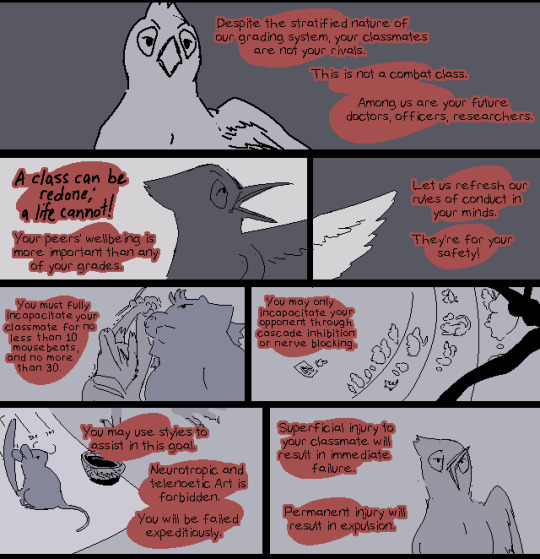
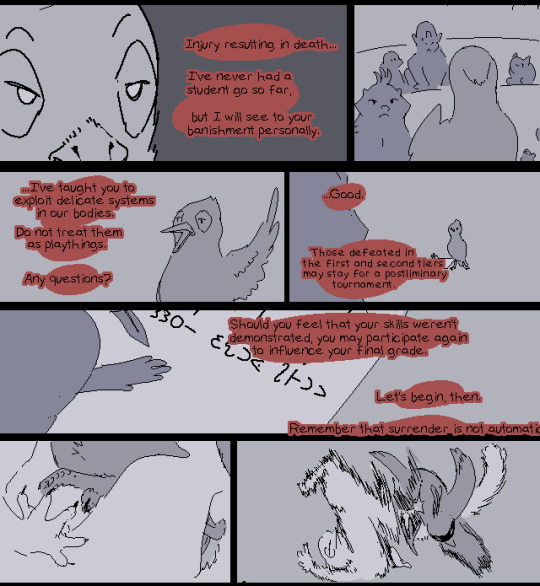
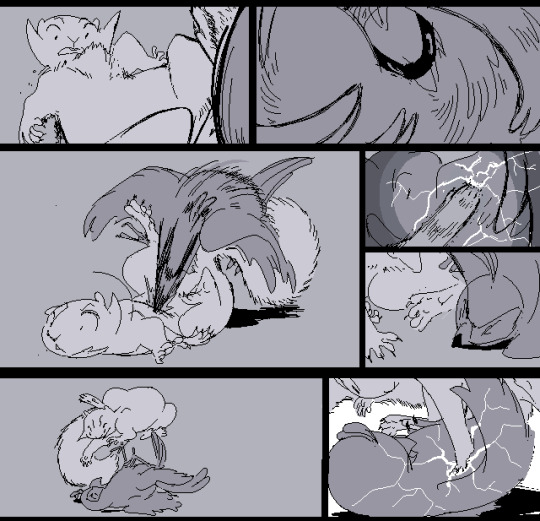
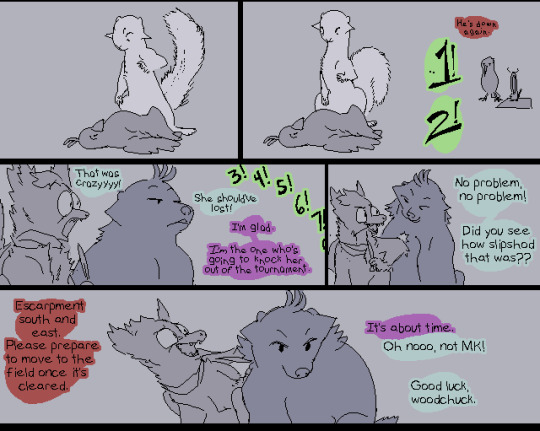
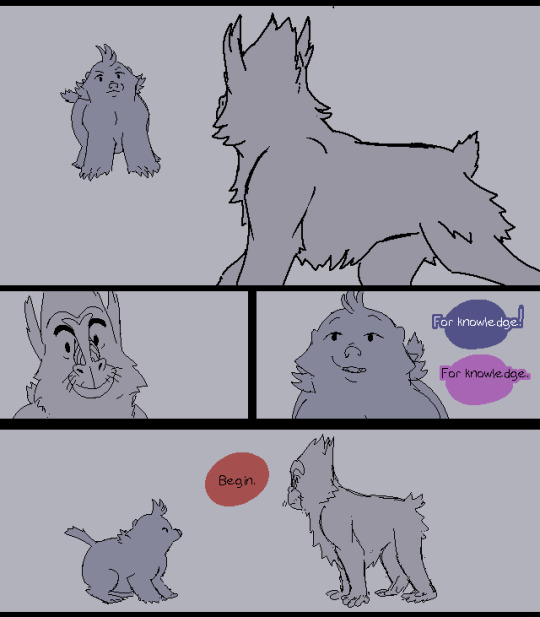
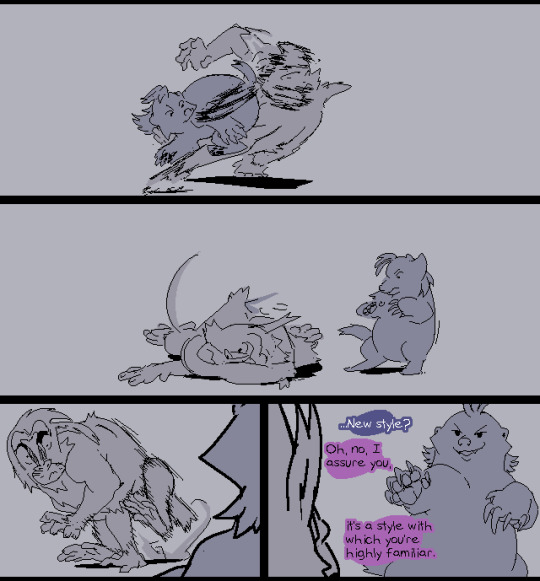
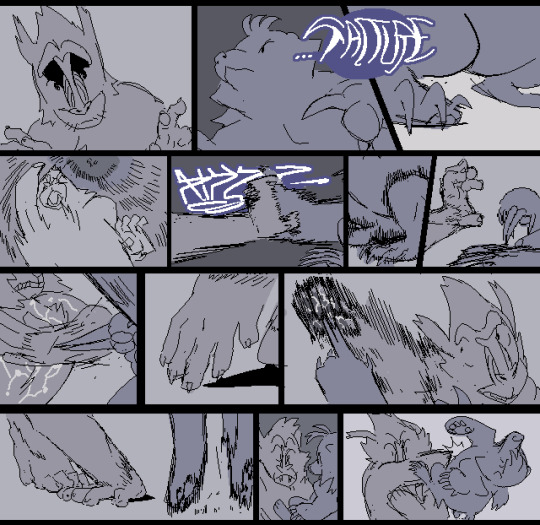
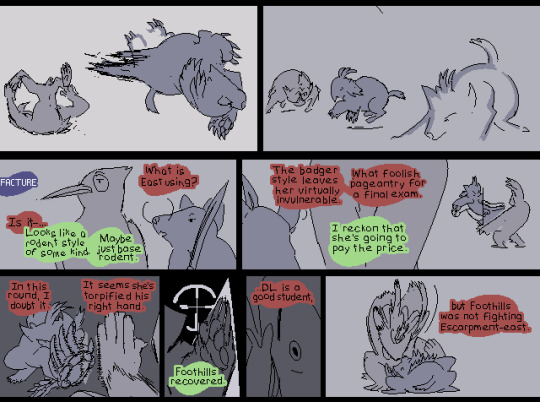
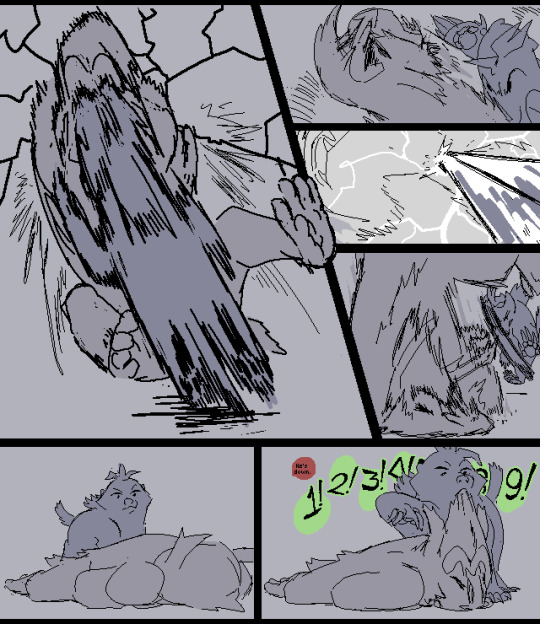
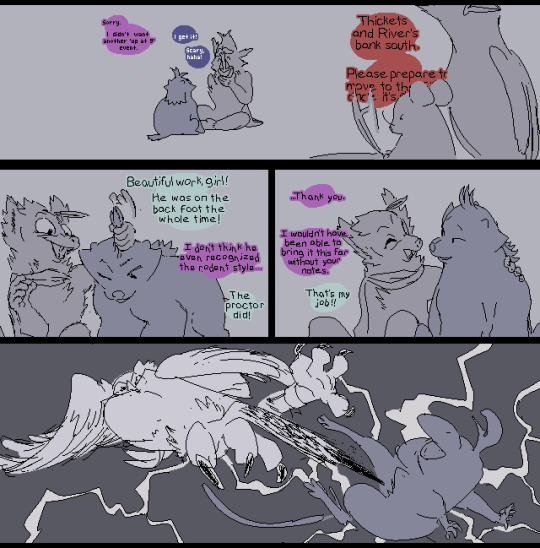
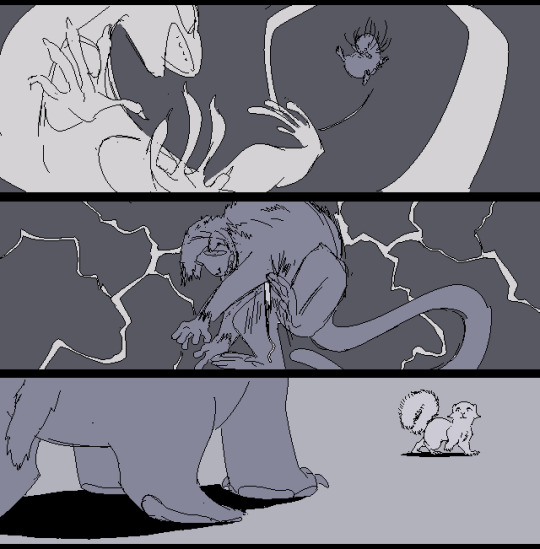
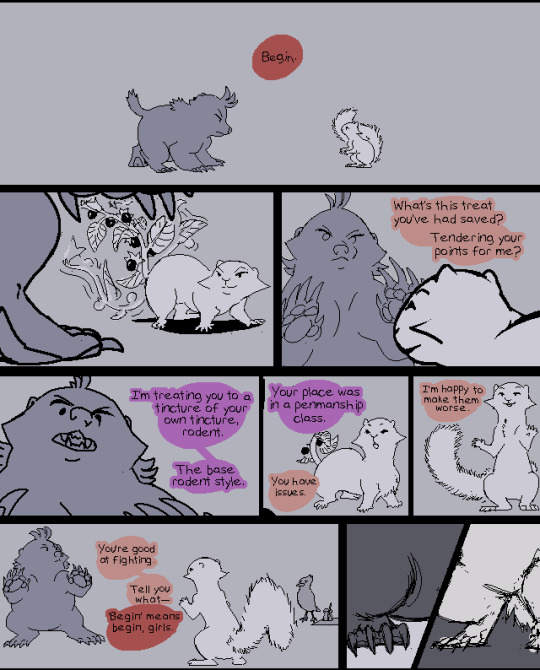
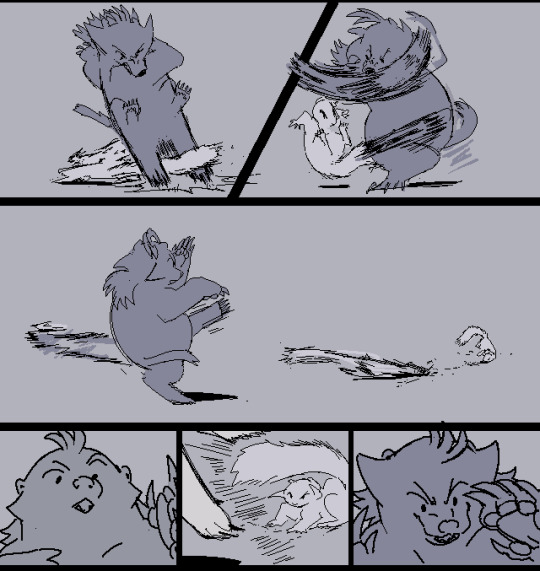
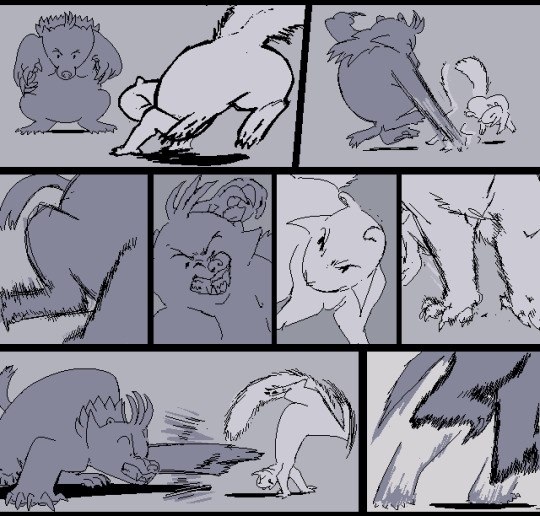
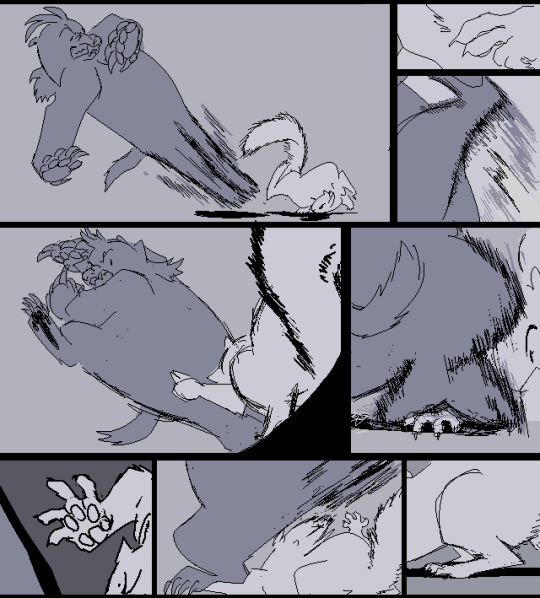
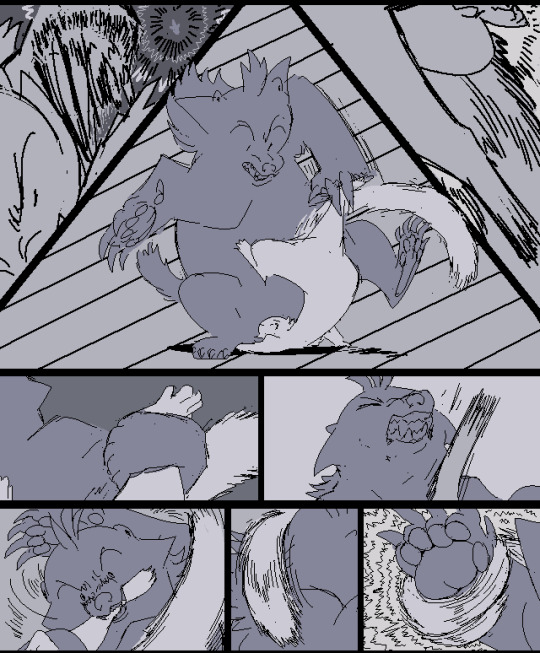
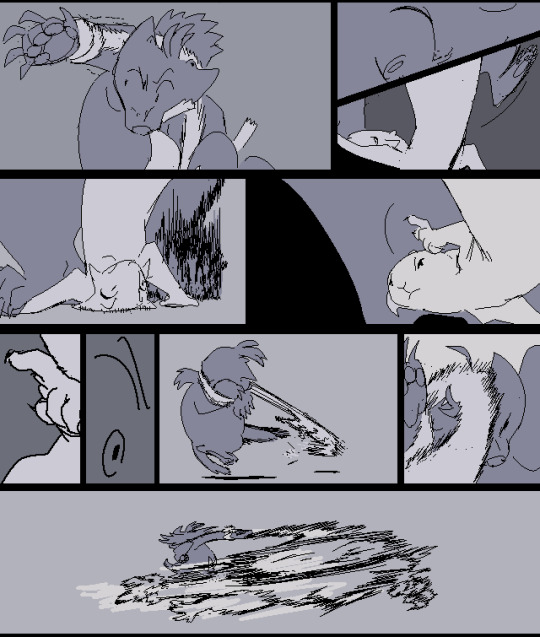
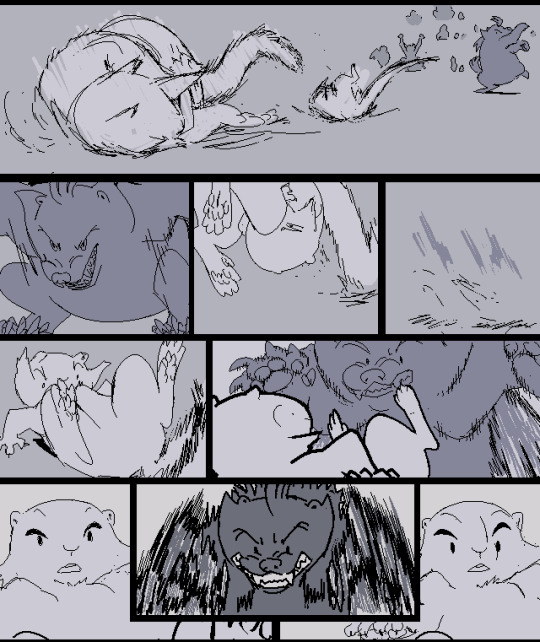
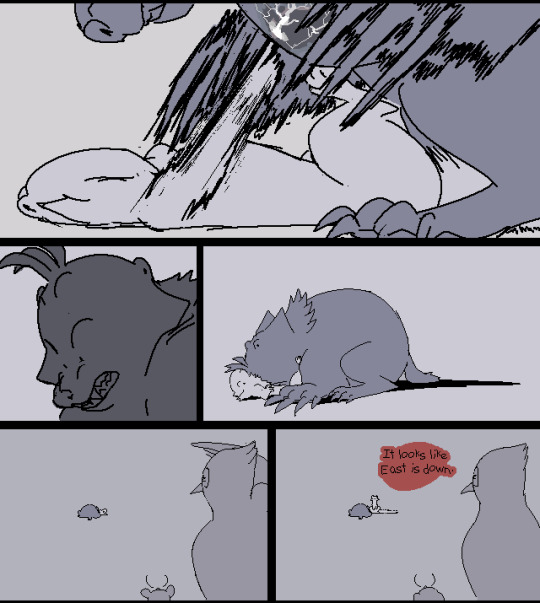
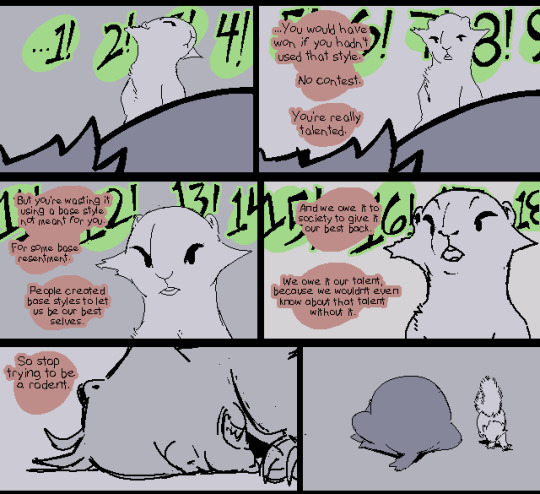
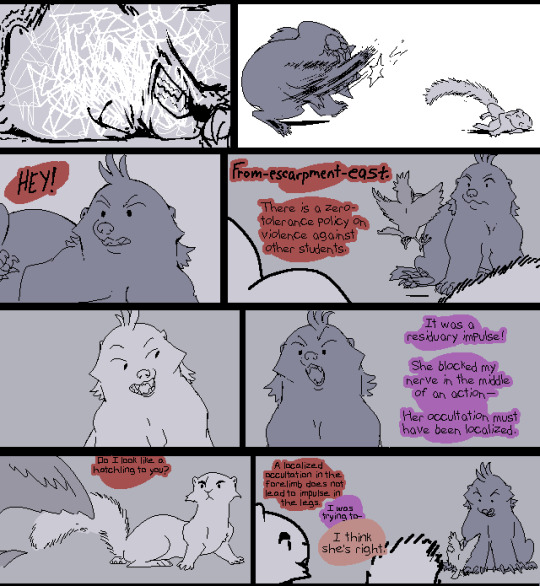
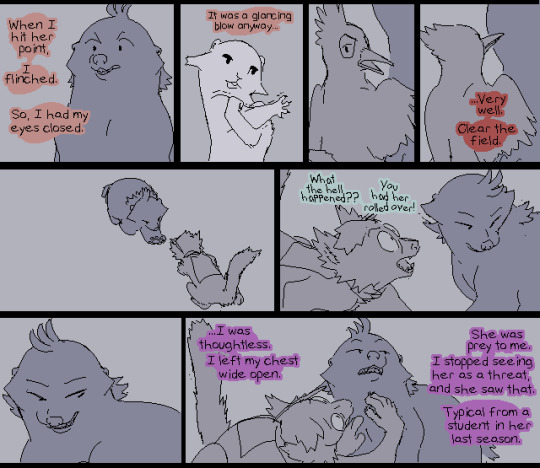
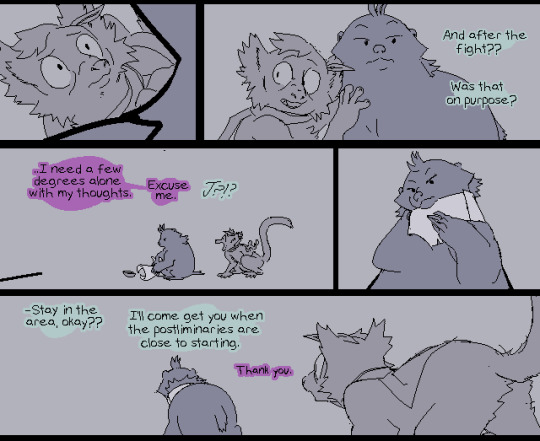
god this shit took forever to sketch. another NofNA emulation comic. it reminds me of the midterms in secretary, for obvious reasons, but Legend is sort of an inverse secretary situation, where she is exceptional at fighting, but wants to write.
let me see what i can remember...
PS, the blue-eyed black lemur, has been friends with Legend since their mutual first season at college, as mentioned above her reference sketch... they probably became more friendly after being paired up to peer edit each others' work. PS has since graduated from college and works as a markscraft. Legend frequently commissions PS to scribe for her, not only because they are friends, but because PS is one of the few markscrafts in the area who isn't a rodent. many primates go into law or medicine. mainly Legend commissions notetaking in classes -- she is too insecure to share her stories. PS has a more relaxed, informal personality, and i tried to get that across -- i think it's relevant to why she decided to become a markscraft instead of pursuing more intense study. still, i also tried to get across that they are good friends, not just scribe and customer, particularly with the amount of touching that PS does. the impulse to touch and groom is probably innate for her as a primate. there isn't as much information about her species, but in ring-tailed lemurs, lemurs usually only groom based on the strongest bonds, rather than more communal aggregate grooming as a sort of social currency. i honestly don't know what PS would need to note during finals, but i think Legend just Wanted her there anyway.
the bird, DL, fighting the squirrel, GG, is a grey shrike. i imagine him as an average student in the middle of his education, but i think he is in the class for combat purposes, because pressure point manipulation can be incredibly powerful, more so if from a less expected species like a bird.
mr. deciding is a much more serious, no-nonsense teacher, possibly due to his specialty. when you're teaching students how to explode a kidney with a handshake, you probably just play it safe and try to put the fear of god into them before any kidneys get exploded. i wanted this class to have a much heavier emphasis on safety of the participants than the class in secretary, with a more focused goal than "who can beat the shit out of each other better." i think the goal of fighting to show off knowledge here is still Fucking Insane, but it's just. their culture, i guess. you can technically "move" your pressure points, so being able to defend yourself by utilizing this knowledge can also show off what you've retained. the mouse next to him is a proctor, who is an extra teacher brought in to judge and often write for another teacher, but primarily as a peacekeeper and bouncer. in classes where a student can theoretically totally disable a teacher by just touching them once, the precaution is seen as necessary. the mouse is probably a combat-oriented point invocation instructor.
the mandrill, MK, is a first-season or first-year student -- i assume that one class, from midterms to finals, is a season, as secretary seems to start near autumn. midterms have snow, and finals are during early spring. anyway, that's tangential. i think he's very new to the educational system. i pictured him as a medical student. in his fighting style, i made him more defensive; he doesn't really know nearly as much about attacking an opponent in a fight. he does think at least about his opponent's most immediate reactions, but doesn't have enough experience with fighting to think ahead to the degree that Legend does. you can see him make the same mistake that Legend did against Machinations, which disables his non-dominant hand. needless to say, he will probably always be aware of headbutt proximity now. he attempts to use two factures in the fight within a style meant to evoke debilitating vertigo by manipulating the connection between the occular, vestibular, and proprioceptive systems. it's obvious that he created the style from his medical classes. it is fairly empty as far as styles go. interrupted facture: nystagmus, which causes the world to spin around the opponent by involuntarily twitching the eyes back and forth. second facture: strabismus, which misaligns the pupils, primarily impeding aim. denied by Legend because a honey badger does not rely on vision or a vestibular system as much as a primate does -- not something he really considered when making the style. factures that never ended up being used: pursuit, which forces the target to follow a spinning image of themselves instead of looking where they should; and mask's lasting, which forcibly initiates saccadic masking, suppressing the intake of new visual information altogether.
the large bird is a bateleur. the mouse is just a regular house mouse. the lizard is an ornate sandveld lizard. the opponent of the lizard is a common mole-rat, also called an african mole-rat (even though most species of mole-rats live in africa). the monkey god i'm not super sure but i believe it's just a vervet monkey. the other mouse is also a common house mouse.
GG is a second-year student, which is the last year for a rodent. i think she's been kind of aimless -- she thinks incredibly fast as a squirrel, and finds solving problems in the moment to be a much more successful endeavor than trying to plan ahead. she doesn't worry about the future and doesn't ruminate on the past much. she's aware that she isn't the best ever and doesn't apply herself as much as others, but it also doesn't particularly bother her. kind of ironic, given the aesop she slops onto Legend after the fight. i imagine that she will eventually choose the name Serendipity. i tried to write her lack of foresight, but compensatory quick thinking in both fights. like the shrike, GG is a combat-oriented student. the style she briefly introduces at the beginning is called fanciful flower's delightful blight. it is based on the deadly nightshade flower and its berries -- which are toxic, obviously, and a hallucinogenic. squirrels flick their tails for many reasons, and the most common reason is simply a default flicking to attract predators. their tails are designed to "deglove" easily; if a predator lunges for their tail, which is the moving part of them, the skin and fur will tear off, and the squirrel can escape. delightful blight utilizes the attention-grabbing flicking of the squirrel's tail as a nightshade plant to induce a trance-like state. the berries represent temptations so much more pleasing than what you ought to focus on. a nice berry and a flower to smell are so much nicer than struggling in a fight. even when you resist them, they linger in your mind, and "plant seeds" when the berry falls as self-restraint is worn down over repeated abstinence from the temptation. factures induce hallucinations and nausea. she primarily uses the base rodent style to fight Legend here, but also uses base squirrel style twists, which include more acrobatics, backflipping, and contortions.
the two things that really catch Legend off-guard use limbs that she doesn't have, and most opponents don't have -- elbows long enough to use defensively, and a long, rope-like tail. she is otherwise supposed to be fairly adept at analyzing what an opponent will do, usually a few steps ahead, related to her ability to fabricate narratives quickly. you can see her also come up with a lie for kicking GG fairly quickly... she was going to say the impulse was in her legs because she was trying to move away from GG's strike.
anyway if any part of this fight is like... unfathomable i can probably explain. i've already been typing for way too long, lmfao
#nofna shitposting#partaking in the act#basically legend left her chest open because she expected GG to attempt to block#instead of considering that GG could take an offensive action instead
163 notes
·
View notes
Text
Hey what the fuck is this news story?
“ But the world’s largest economies are already there: The total fertility rate among the OECD’s 38 member countries dropped to just 1.5 children per woman in 2022 from 3.3 children in 1960. That’s well below the “replacement level” of 2.1 children per woman needed to keep populations constant.
That means the supply of workers in many countries is quickly diminishing.
In the 1960s, there were six people of working age for every retired person, according to the World Economic Forum. Today, the ratio is closer to three-to-one. By 2035, it’s expected to be two-to-one.
Top executives at publicly traded US companies mentioned labor shortages nearly 7,000 times in earnings calls over the last decade, according to an analysis by the Federal Reserve Bank of St. Louis last week.
“A reduction in the share of workers can lead to labor shortages, which may raise the bargaining power of employees and lift wages — all of which is ultimately inflationary,” Simona Paravani-Mellinghoff, managing director at BlackRock, wrote in an analysis last year. “
Is this seriously how normal people think? Improving the bargaining power of workers and increased wages are bad?
“ And while net immigration has helped offset demographic problems facing rich countries in the past, the shrinking population is now a global phenomenon. “This is critical because it implies advanced economies may start to struggle to ‘import’ labour from such places either via migration or sourcing goods,” wrote Paravani-Mellinghoff.
By 2100, only six countries are expected to be having enough children to keep their populations stable: Africa’s Chad, Niger and Somalia, the Pacific islands of Samoa and Tonga, and Tajikistan, according to research published by the Lancet, a medical journal.
BlackRock’s expert advises her clients to invest in inflation-linked bonds, as well as inflation-hedging commodities like energy, industrial metals and agriculture and livestock.
Import labor via migration or sourcing goods? My brother in Christ they are modern day slaves!! I feel like I’m in backwards town reading this what the fuck?!
“ Elon Musk, father of 12 children, has remarked that falling birthrates will lead to “a civilization that ends not with a bang but a whimper, in adult diapers.”
While his words are incendiary, they’re not entirely wrong
P&G and Kimberly-Clark, which together make up more than half of the US diaper market, have seen baby diaper sales decline over the past few years. But adult diapers sales, they say, are a bright spot in their portfolios. “
Oh now the guy with a breeding kink is going to lecture us. Great. /s
“ The AI solution: Some business leaders and technologists see the boom in productivity through artificial intelligence as a potential solution.
“Here are the facts. We are not having enough children, and we have not been having enough children for long enough that there is a demographic crisis, former Google CEO and executive chairman Eric Schmidt said at the Wall Street Journal’s CEO Council Summit in London last year.
“In aggregate, all the demographics say there’s going to be shortage of humans for jobs. Literally too many jobs and not enough people for at least the next 30 years,” Schmidt said.
Oh god not the AI tech bros coming into this shit too. Wasn’t the purpose of improving tech to give people more free time? So they can relax and spend time with family more and actually enjoy life? Isn’t our economy already bloated with useless pencil-pushing number-crunching desk jobs that ultimately don’t serve a purpose?
I’m not going to post the entire article but give it a read. It’s… certainly something. Anyway degrowth is the way of the future.
53 notes
·
View notes
Text
Imperator Butterpants, my charge for the weekend, had treed a squirrel in the park. Normally, I would help out the dog - that’s what is humans are for - but there’s a complication. A nearby toddler birthday party would be ruined by the sight of my aunt’s Pomeranian ripping a domestic rodent in half for fun. That’s the tragedy of the commons, right there. Exactly what Plato was talking about.
As a result, I squat gently and prepare myself to pick up the dog in a caring embrace. This feels natural, comforting. I am communing with my ancestors who tamed his ancestors, and in a moment I will have experienced the sensation of another living thing obeying my demands. Nothing doing. Butterpants turns around, snaps at my face, and dislodges my 3M Tekk P100 respiratory-particulate-protection bayonet fitting mask slightly. We are going home, I declare to a dog that does not understand English.
Luckily for me, I have prepared a vessel for transporting the dog. It is a sidecar consisting of an old bumper car, hastily welded with leftover Home Depot fence strapping (don't worry, I ground off most of the galvanization) to the side of a Razor Pocket Mod child's electric scooter. Well, I say "child's," but we both know that's some bullshit that I trot out to make the cop think it's impossible that I break the speed limit on this pink piece of plastic. In actuality, I know that there is no way that the officer is tuned-in enough to electronic engineering to realize that the several hundred pounds of lithium ion phosphate pouch batteries ziptied together under the seat is easily enough stored energy to launch this thing into low earth orbit should I decide to whack the throttle bare open. Plus, it means I can ride in the bike lane, which is good. Have you seen what kind of maniacs drive cars?
Despite what I just told you, I pin the throttle nonetheless, knowing that the aggregate resistance of the battery cables momentarily turning to a liquid will act as a sort of dynamic throttle control. We are off, both figuratively and literally. You might have encountered in the past a dog wearing "doggles," which is a portmanteau of the word "dog" and "goggles." Eye protection for dogs is absolutely critical at these kinds of velocities, and it is for that reason that I have placed a welding mask on the muzzle of my aunt's dog, protecting him from impacts with bugs, gravel, and other multi-use-pathway users.
We get home in quite a hurry, so much so that I have to use my neighbour's garden hose to extinguish the foam-rubber tires bonded to the rear hub motor. Imperator Butterpants is dazed initially, having reached a land speed formerly only attempted by dogs named Laika, but soon recovers. And, hey! We got that squirrel after all, although I'm pretty sure I'll have to peel it off of the welding mask and run it through a strainer before I can put it in with his Ol' Roy.
224 notes
·
View notes
Note
What the fuck did you just fucking say about me, you little bitch? I'll have you know I graduated top of my class in the Navy Seals, and I've been involved in numerous secret raids on Al-Quaeda, and I have over 300 confirmed kills. I am trained in gorilla warfare and I'm the top sniper in the entire US armed forces. You are nothing to me but just another target. I will wipe you the fuck out with precision the likes of which has never been seen before on this Earth, mark my fucking words. You think you can get away with saying that shit to me over the Internet? Think again, fucker. As we speak I am contacting my secret network of spies across the USA and your IP is being traced right now so you better prepare for the storm, maggot. The storm that wipes out the pathetic little thing you call your life. You're fucking dead, kid. I can be anywhere, anytime, and I can kill you in over seven hundred ways, and that's just with my bare hands. Not only am I extensively trained in unarmed combat, but I have access to the entire arsenal of the United States Marine Corps and I will use it to its full extent to wipe your miserable ass off the face of the continent, you little shit. If only you could have known what unholy retribution your little "clever" comment was about to bring down upon you, maybe you would have held your fucking tongue. But you couldn't, you didn't, and now you're paying the price, you goddamn idiot. I will shit fury all over you and you will drown in it. You're fucking dead, kiddo. /copypasta
i did recognize the copypasta by the second sentence or so but i do appreciate you clarifying as well, because this is how the notification first appeared:

and i was worried that i had put out a truly despicable hot take on one of my terrible structures
letter sequence in this ask matching protein-coding amino acids:
WhatthefckdidystfckingsayatmeylittleitchIllhaveyknwIgradatedtpfmyclassintheNavySealsandIveeeninvlvedinnmerssecretraidsnAlQaedaandIhavevercnfirmedkillsIamtrainedingrillawarfareandImthetpsniperintheentireSarmedfrcesYarenthingtmetstanthertargetIwillwipeythefcktwithprecisinthelikesfwhichhasnevereenseenefrenthisEarthmarkmyfckingwrdsYthinkycangetawaywithsayingthatshittmevertheInternetThinkagainfckerAswespeakIamcntactingmysecretnetwrkfspiesacrsstheSAandyrIPiseingtracedrightnwsyetterpreparefrthestrmmaggtThestrmthatwipestthepatheticlittlethingycallyrlifeYrefckingdeadkidIcaneanywhereanytimeandIcankillyinversevenhndredwaysandthatsstwithmyarehandsNtnlyamIetensivelytrainedinnarmedcmattIhaveaccessttheentirearsenalfthenitedStatesMarineCrpsandIwillseittitsflletenttwipeyrmiseraleassffthefacefthecntinentylittleshitIfnlyycldhaveknwnwhatnhlyretritinyrlittleclevercmmentwasattringdwnpnymayeywldhaveheldyrfckingtngetycldntydidntandnwyrepayingthepriceygddamniditIwillshitfryallveryandywilldrwninitYrefckingdeadkidd
protein guy analysis:
in light of my recent post about intrinsically disordered proteins and aggregation, i am trying really hard to ignore the instincts that are telling me how terrible this looks. the loops aren't even pretending to interact with each other, and the secondary structures are small and scattered. the good news is that this probably can't aggregate since it can't stick to anything, but it still has a long way to go. to me, the suspiciously straight loop around the front of the structure is also an immediate red flag, as it matches a row of cis bonds, but given that this thing would not have a stable crystal structure anyways, it doesn't actually matter
predicted protein structure:

#science#biochemistry#biology#chemistry#stem#proteins#protein structure#science side of tumblr#protein asks#protein memes
34 notes
·
View notes
Text
Pheromones, Packs, and Bonding Bites
Scents and biting are a staple in Omegaverse but I feel like I haven't seen a ton of really in-depth worldbuilding about how they work. Even fics with otherwise extremely in-depth speculative biology tend to just slap Magic Psychic Mating Bites in there and call it good. Which is fine, of course, but I figured I'd share my own thoughts on the whole thing for anybody else who's interested.
First, we gotta talk a little bit about scents. "Scents" in Omegaverse typically refer to pheromones, which are actually not really scents at all. Or, well. They do have a smell, but that'd be like saying words are sounds. Pheromones are a form of chemical communication. Species that use Pheromones don't just waft them through the air for no reason. They're a language, meant to express particular concepts among members of the same species. Because of this, pheromones are pretty specific. The pheromones bees use to communicate and the pheromones ants use to communicate are completely different; they're speaking different languages.
There are also Allelomones, which are used to communicate between different species, and we'll talk about that in a sec.
What does that have to do with bonding bites? Well, just about everything, actually. In my worldbuilding, exchanging bites injects a venomous compound in the saliva, which chemically alters a person's body, making them able to pick up on your pheromones. Bonding bites are not unique to mated pairs, and are instead a social activity shared between all pack-mates -- especially those who are not biologically related -- in order to create a sort of closed circle of communication. People who are not pack-bonded to you can still pick up on the "main" or "base" scents (your gender, general age markers, some amount of what emotions you're experiencing, that kind of thing) as well as being able to smell your pack on you and you on them, but they can't communicate with you via scent the way you would communicate with your pack.
Okay, so what exactly are these communications? Here's the ones I use.
Aggregate Pheromones are used to gather members of a group to a certain location. All genders produce aggregate pheromones in different forms. Alphas use aggregate pheromones to mark their territory, and these scent-marks are only detectable to the Alpha's bonded pack. The scent is long-lasting but doesn't tend to spread very far, staying localized within the general area of the territory. Omega aggregate pheromones tend to spread quite far beyond the den and territory, but don't last as long or as potently, and are typically meant to actively summon the pack to the omega's nest, whereas Alpha aggregate pheromones are more like a welcome mat. They're produced most often during heat, and are detectable to people who are not bonded pack, which is part of why people are so protective of their omega pack-mates during heat. Betas produce only short bursts of aggregate pheromones that do not linger on objects in their environment, however Beta aggregate pheromones are the "sharpest" and have the strongest compelling effect on calling their pack-mates to them. Basically Alphas mark their territories like a light house, Omegas mark their territories like the smell of food wafting out of the kitchen when you're hungry, and Betas scream Come Here Right Now directly up your nose.
This brings us to territorial pheromones, which are actually allelomones, meaning they're meant to communicate with people who are Not in your bonded pack. Alpha territorial pheromones are most concentrated in their urine and are used to mark the edges of their den and territory. Omega territorial pheromones are most concentrated in their saliva and are used to mark the edges of their nest, or groomed onto pack-mates (particularly pups) as a public claim. Betas typically mark within the bonds of an Alpha's territory. Their Territorial Pheromones are also generally most concentrated in their urine, but they can produce omega-like territorial pheromones in their saliva if their pack needs them to for any reason.
Defensive Rings (or Trap Pheromones) are a chemical cocktail caused by the interactions between Alpha, Beta, and Omega territorial pheromones. An Alpha can mark a territory without laying a trap, but they will rarely do so. The trap pheromone is undetectable to anyone who is not pack, however it will cling to skin of anyone who passes through the alpha's territory. If the intruder enters the ring of beta pheromones, a chemical reaction will occur that is unpleasant and repellent. This can be pushed through -- someone can even build up a tolerance to it -- but it is extremely uncomfortable for the person in question. If the intruder then continues deep enough into the pack's territory to come near the nests and the omega pheromones therein, the chemical reaction increases and becomes actively painful, similar to being maced. To invite a guest safely into your territory without triggering these traps you need only scent them thoroughly before they enter.
Alarm Pheromones are released when attacked or otherwise in danger and are meant to trigger either retreat or aggression in bonded pack. Omegas produce an Alarm Pheromone that triggers aggression and is used to mark an enemy. This pheromone is actively repellent to non-pack-bonded Alphas and will typically drive them away or make them reluctant to approach. Alphas who are pack-bonded to the omega will not be repelled. Alpha alarm pheromones can be used on either a person or the environment and are meant to trigger flight rather than fight -- run away, do not go near, proceed with caution. Beta alarm pheromones are a warning call that are not meant to immediately trigger a response in their pack-mates other than a call to attention and to be prepared. Betas do not mark enemies or environments with this scent, instead sending out the warning from their own bodies. It's a message that Something Is Wrong and needs to be investigated, or a call to arms for the pack to brace for oncoming danger.
Trail Pheromones are a trait unique to pup-hood. Children produce trail pheromones from the pads of their hands and feet, and will habitually touch things in their environment as they travel. This is done both so the pup can find their way back to their pack should they get lost, and so their pack can find them. Pups can also produce a homing scent which is extremely potent and travels very far, but cannot be detected by any adult that is not pack-bonded to the child. This allows the pup to broadcast their location to their pack without exposing themselves to a strange, potentially dangerous adult.
The flip side of this, adults who have given birth are able to release something akin to a Nasonov Pheromone, which acts as a beacon to their young. Like the pup's homing pheromones, this is a scent meant to spread extremely far in a short amount of time, without attracting the attention of a non-pack adult.
All genders can produce Calming and Appeasement pheromones, but Betas are the only gender who can weaponize them. A Beta scent naturally carries a slight sedative and soporific quality, which is why Betas produce less oil from their scent glands than their Alpha and Omega counterparts. However, betas can increase the potency of their scent and thus the effectiveness of their pheromones either to soothe a pack-mate when in distress or to weaken a potential enemy when in danger.
And then of course there are all of the obvious horny fuck-time pheromones. Alphas produce pheromones during their rut that are actively repellent to non-pack alphas and generally smell kind of gross and off-putting to non-back omegas and betas. However the alpha's pack will generally find the scent pleasant, and possibly arousing. In contrast, Omega heat scents are generally appealing to everyone, not just their bonded pack. A Beta exposed to the pheromones of their heating or rutting pack-mates might enter a sympathetic heat or rut as a result.
28 notes
·
View notes
Text

first lines! :D
HI ALL! I'll put all tags below the cut so they don't clog up a bunch of paragraphs with the glitch, but thank you for thinking of me friends! I love reading through your works again and gathering up reread material jhgskjgf <333
(but if anyone's not done this yet, please feel free to use this as an OPEN TAG!!!!!!)
--
RULES: post the first lines of your last 10 fics/chapters posted on AO3 (if you have less than 10 fics posted, post the first lines of all your fics) and try to draw some conclusions.
--
i. Nora scrubs at the exam table with the antiseptic cleanser, reveling in the quietness of the clinic tonight. (x)
ii. “I need you to bite me.” (x)
iii. It’s not the kind of place Alex ever thought he’d find himself visiting. (x)
iv. Ultimately, it’s an ankle that does it. (x)
v. “In civil engineering, Abrams’ law describes the strength of which type of building material that is composed of fine and coarse aggregate bonded together?” (x)
vi. Soft Chew Bakery Dog Biscuits, 15-count, pack of 3 (x)
vii. Alex has a plan. (x)
viii. The graveyard is quiet today. (x)
ix. When Alex graduated high school, his senior superlative was Most Independent. (x)
x. It’s past midnight and snowing in New York when Henry learns how to breathe again. (x)
+
conclusions:
look, ultimately the goal is usually either to confuse y'all or to plunge you straight into the deep end with a seemingly innocuous fact that ends up being pivotal to the plot line in the end so kjhdgfkjshgf IDK I HOPE THAT'S WHAT COMES ACROSS !!!
+
thank you for the tags friends! @kiwiana-writes @sparklepocalypse @read-and-write- @gay-flyboys @run-for-chamo-miles !!!!!
once again this is an OPEN TAG but I'll nudge a few peeps if you're feeling up for it! (apologies if you've already participated!)
@firenati0n @wordsofhoneydew @nocoastposts @cha-melodius @everwitch-magiks
@inexplicablymine @getmehighonmagic @clockwrkpendrxgon @orchidscript @blueeyedgrlwrites
@hgejfmw-hgejhsf @whimsymanaged @seths-rogens @cricketnationrise @anchoredarchangel
@rmd-writes @eusuntgratie @stellarmeadow @porcelainmortal @iboatedhere
xx
20 notes
·
View notes
Text

Title: Nature Vs. Natue
Suggested Reading
! - Highly Recommended
Researching Witchcraft Herbology ! Introduction to Gnosis ! Fundamentals of Energy Work The Path of Least Resistance ! Finding Balance ! Spell Design ! Spell Dictation Spellcasting Basics
Introduction
Witchcraft, often understood as a practice interwoven with the natural world, exhibits a profound connection to various definitions of "nature." Two predominant conceptualizations of "nature" come to the fore when analyzing this intricate bond: one rooted in the tangible external environment, replete with diverse fauna and flora, and the other abstractly referring to the overarching laws governing the cosmos.
Nature as Fauna and Flora
In many cultural traditions, nature, delineated as the external world filled with myriad species of land, sky, plants, and animals, plays an integral role in the practice of witchcraft. This view accentuates the symbiotic relationship between the practitioner and their environment. Indigenous practices, for instance, often emphasize the importance of respecting the land, understanding the medicinal properties of herbs, and acknowledging the spirits of animals. From this perspective, nature is not a mere backdrop but an active participant, facilitating the rituals and spells that constitute witchcraft.
Moreover, the reciprocity between humans and the natural world underscores the idea that every action has a consequence, a fundamental tenet in various witchcraft traditions. Plants, for example, might be harvested for their medicinal or magical properties, but there's an implicit understanding of the necessity of sustainable harvesting and giving back to the land; or conversely, consuming a plant that is poisonous.
Nature as Cosmic Laws
A more precise understanding of "nature" pertains to the laws that regulate the aggregate being of the universe. These are known as the inviolable principles governing the operations of the cosmos. In the context of witchcraft, recognizing and aligning oneself with these universal principles is paramount. By doing so, a practitioner might better navigate the complexities of existence, deriving insights and gaining an enhanced ability to influence their circumstances within the boundaries set by these cosmic laws.
Nature's Significance in Witchcraft
The dual interpretations of "nature" elucidate the depth of their connection to witchcraft. On one hand, the palpable surroundings with its environments untouched by man, provides both the tools and the context for the craft, emphasizing symbiosis and respect. On the other, the more abstract understanding invites practitioners to delve deeper, contemplating the foundational principles that weave the fabric of reality itself. Together, these conceptions of nature serve as pillars that uphold the conceptualization of witchcraft, anchoring it in both the tangible world and the vast expanse of the universe.

Nature in Witchcraft: Exploring the External Natural World
Witchcraft, an umbrella term for diverse practices commonly rooted in the rhythms of the natural world, encapsulates varying traditions that venerate the Earth and its abundant life forms. By examining Green Witchcraft and Animism, we gain a comprehensive understanding of the profound nexus between witchcraft and nature. Green Witchcraft does not perceive nature as a mere assemblage of resources to be used and discarded. Instead, nature is deemed a living, breathing entity that sustains life and fosters interconnectedness. Practitioners of this craft often align their practices with the cycles of the moon, the changing seasons, and the transitions of day and night. They understand that nature pulses with life, and by attuning themselves to these rhythms, they harmonize their actions and beliefs with the world around them. This alignment provides a framework for them to develop rituals, spells, and practices that respect and honor the Earth's vitality.
Reverence for Plants, Animals, and Landscapes
Green witches hold an intrinsic appreciation for the myriad life forms with which they share the planet. Plants, whether towering trees or humble herbs, are viewed as powerful allies with distinct properties that can be harnessed for both medicinal and magical purposes. Animals, too, play a pivotal role, with many Green witches recognizing the significance of animal guides, familiars, icons, or totems in their practice. Various landscapes, be they serene woodlands, expensive deserts, or rugged coastlines, are also revered for their unique energies and contributions to the global ecosystem. For Green witches, every component of nature, animate or inanimate, deserves respect and is approached with a sense of humility and gratitude.
Animism
Animism, while not exclusive to witchcraft, offers invaluable insights into the profound spiritual connections between humans and the natural world. At its core, animism posits that all things, whether organic or inorganic, possess a spirit and intrinsic worth. This syncretic belief system holds that everything, from the grandest mountain to the smallest pebble, has a spirit or energy. Such a perspective invites a profound sense of wonder and reverence for the world, as one recognizes the multitude of spirits and energies that coexist alongside humanity. Animistic beliefs underscore the interconnectedness of all things and challenge the anthropocentric view that humans hold dominion over nature.
Recognition of the Divine Presence in Nature
Animism also postulates the ubiquity of the divine in the natural world. This doesn't merely refer to lofty deities overseeing creation from a distance; it's about the imminent divinity in the rustling leaves, the flowing rivers, and the chirping birds. By acknowledging this divine essence, practitioners can cultivate a deeper, more meaningful relationship with their surroundings, treating every interaction with nature as a sacred encounter.

Nature as the Laws of the Universe
The universe is woven with threads of both observable phenomena and more elusive principles. These fundamental laws, which transcend much physical observation, provide a blueprint for understanding existence. When viewing witchcraft through this lens, it becomes apparent that these universal tenets are paramount to a practitioner's understanding and execution of their craft. By juxtaposing these principles with science, technology, engineering, and mathematics (STEM), we uncover a harmonious fusion, bridging mystical practices with modern knowledge.
Understanding Metaphysical Principles
Metaphysics, a branch of philosophy, grapples with questions about existence, reality, and the nature of the universe that often elude empirical observation. These principles serve as the bedrock for many spiritual and mystical traditions, including witchcraft. By acknowledging these universal laws, a practitioner can align their craft with the rhythm of existence. It's akin to understanding the ebb and flow of the tides; by recognizing the currents, one can navigate more effectively. In essence, these metaphysical perspectives guide how energy, transformation, and change could operate in the universe.
Gnosis
Gnosis, derived from the Greek word for "knowledge," is typically a term meaning mystical understanding and personal revelation. It's not mere bookish knowledge but an experiential comprehension of universal truths.
At its core, gnosis seeks a profound connection with the universe, transcending the limitations of conventional perception. Through introspection, meditation, and various other practices, individuals endeavor to attain a heightened state of awareness, shedding layers of superficial understanding to grasp the profound depths of reality within a desired scope of reference.
It is through a state of gnosis that the foundational concepts of various applications of STEM are truly utilized. When entering the headspace for a working, if the conceptual understandings of related physical laws are present in your mind- the efficacy of the spell increases dramatically.
Gaining Insight into the Laws and Workings of the Universe
The pursuit of gnosis is not merely for personal edification; it can also be a tool in a quest to comprehend the intricacies of the universe. By employing this tool, practitioners can align their actions and practices with these cosmic principles, ensuring that their craft resonates harmoniously with the natural order. Achieving a state of gnosis often requires transcending the bounds of normalized daily consciousness. Through practices like meditation, rhythmic drumming, or even dance or walking, an individual might enter a trance state, allowing for complete focus on a specific concept, which can gradually be used in unlocking deeper layers of understanding and facilitating a more direct connection with the universe's laws.
Application of STEM Concepts in Witchcraft
While witchcraft taps into metaphysical principles and energies, it doesn't operate in a vacuum. The physical laws of the universe, modeled by the disciplines of STEM, still apply. For instance, a spell might facilitate healing or protection, but it cannot violate conservation of energy or other fundamental scientific tenets.

Combining Concepts of Nature & Nature
By melding the tangible aspects of nature, such as plants and animals, with the abstract laws of the universe, a holistic understanding of witchcraft emerges. This synthesis bridges the gap between witchcraft and STEM, showing that they're not at odds but rather two facets of the same gem. For instance, understanding the chemical properties of a herb, its ecological role, and its metaphysical significance or energetic properties can enrich a ritual or spell, making it more potent and efficient.
Utilizing STEM to Find the Path of Least Resistance and Means of Manifestation for Spellwork
STEM offers tools and methodologies to streamline and enhance witchcraft practices. By understanding physical laws, practitioners can identify the most efficient and effective ways to channel energies. For instance, if one were to craft a salve, understanding the chemical reactions involved, the energetic properties of the ingredients, and the optimal conditions for emulsion could potentiate the concoction's effectiveness. This integration ensures that spellwork is not only spiritually resonant but also optimized within the boundaries set by science.
This nexus between nature's tangible expressions and its underlying laws provides a comprehensive framework for understanding and practicing witchcraft. By integrating metaphysical insights with STEM knowledge, a harmonious and potent fusion emerges, positioning witchcraft not as an antiquated relic but as a dynamic practice intertwined with both ancient wisdom and modern understanding.
Integration and Practice
A nuanced approach to witchcraft embraces both the tangible resources our Earth generously offers and the intricate principles that govern the universe. By harmoniously integrating these facets, practitioners can cultivate a potent and authentic practice. This interplay is distinctly evident when examining Green Witchcraft, Kitchen Magic, and the alignment with universal laws.

Green Witchcraft and Kitchen Magic
At the forefront of Green Witchcraft and Kitchen Magic is the utilization of natural elements. Here, the emphasis is not on classical elements like fire or air, but rather on tangible materials, including herbs, stones, and water. For instance, a Green Witch might incorporate rosemary, known for its protective qualities, in a spell, while someone practicing Kitchen Magic might bake a loaf of bread, infusing it with specific energies through each kneading motion. This palpable connection to the environment ensures that the rituals and spells remain grounded and potent.
Going Beyond Correspondences in Green & Kitchen Magic
While it's common to associate specific attributes to various natural elements, Green Witchcraft and Kitchen Magic should transcend mere symbolic associations. Instead of merely linking, say, lavender with peace because of a traditional correspondence, a practitioner might delve deeper, researching its energetic properties, botanical properties, ecological roles, and historical uses. This encompassing approach enhances the depth and efficacy of the spellwork, rooting it not just in symbolic representation but in genuine understanding and connection, which allows for more than a psychological or physiological effect.

Aligning with the Laws of the Universe
To view the vast expanse of existence and harness its potential, it's imperative to align one's practices with the fundamental laws of the universe. This doesn't merely pertain to abiding by these principles, but actively synergizing with them. It's about recognizing the ebb and flow of energy and entropy and discerning the most opportune moments to conduct rituals or cast spells.
Designing Spells that Work Within the Confines of Natural Laws
Creating a spell is akin to formulating a hypothesis in science. It requires precision, understanding, and respect for the boundaries set by nature. To ensure that a spell is efficacious, it must be designed to operate within the confines of natural laws. This might mean acknowledging the limitations of what can be achieved, but it also ensures that the energies harnessed are potent and resonant. For example, instead of attempting to counteract a natural phenomenon, one might seek to harmonize with it, creating a balance that benefits both the practitioner and the environment.
This post contains all of my articles!

Patreon Shoutouts!
Meegs
Jinsu
Cosmicaquamarine
Those who support me on Patreon, had access to this article two weeks in advance! If you're considering supporting me, see more details.
This articles was reviewed & edited by ChatGTP.
72 notes
·
View notes
Text
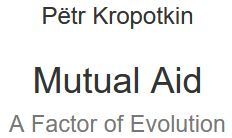
Chapter 5: Mutual Aid in the Mediæval City
Growth of authority in Barbarian Society. — Serfdom in the villages. — Revolt of fortified towns: their liberation; their charts. — The guild. — Double origin of the free mediæval city. — Self-jurisdiction, self-administration. — Honourable position of labour. — Trade by the guild and by the city.
Sociability and need of mutual aid and support are such inherent parts of human nature that at no time of history can we discover men living in small isolated families, fighting each other for the means of subsistence. On the contrary, modern research, as we saw it in the two preceding chapters, proves that since the very beginning of their prehistoric life men used to agglomerate into gentes, clans, or tribes, maintained by an idea of common descent and by worship of common ancestors. For thousands and thousands of years this organization has kept men together, even though there was no authority whatever to impose it. It has deeply impressed all subsequent development of mankind; and when the bonds of common descent had been loosened by migrations on a grand scale, while the development of the separated family within the clan itself had destroyed the old unity of the clan, a new form of union, territorial in its principle — the village community — was called into existence by the social genius of man. This institution, again, kept men together for a number of centuries, permitting them to further develop their social institutions and to pass through some of the darkest periods of history, without being dissolved into loose aggregations of families and individuals, to make a further step in their evolution, and to work out a number of secondary social institutions, several of which have survived down to the present time. We have now to follow the further developments of the same ever-living tendency for mutual aid. Taking the village communities of the so-called barbarians at a time when they were making a new start of civilization after the fall of the Roman Empire, we have to study the new aspects taken by the sociable wants of the masses in the middle ages, and especially in the mediæval guilds and the mediæval city.
Far from being the fighting animals they have often been compared to, the barbarians of the first centuries of our era (like so many Mongolians, Africans, Arabs, and so on, who still continue in the same barbarian stage) invariably preferred peace to war. With the exception of a few tribes which had been driven during the great migrations into unproductive deserts or highlands, and were thus compelled periodically to prey upon their better-favoured neighbours — apart from these, the great bulk of the Teutons, the Saxons, the Celts, the Slavonians, and so on, very soon after they had settled in their newly-conquered abodes, reverted to the spade or to their herds. The earliest barbarian codes already represent to us societies composed of peaceful agricultural communities, not hordes of men at war with each other. These barbarians covered the country with villages and farmhouses;[156] they cleared the forests, bridged the torrents, and colonized the formerly quite uninhabited wilderness; and they left the uncertain warlike pursuits to brotherhoods, scholæ, or “trusts” of unruly men, gathered round temporary chieftains, who wandered about, offering their adventurous spirit, their arms, and their knowledge of warfare for the protection of populations, only too anxious to be left in peace. The warrior bands came and went, prosecuting their family feuds; but the great mass continued to till the soil, taking but little notice of their would-be rulers, so long as they did not interfere with the independence of their village communities.[157] The new occupiers of Europe evolved the systems of land tenure and soil culture which are still in force with hundreds of millions of men; they worked out their systems of compensation for wrongs, instead of the old tribal blood-revenge; they learned the first rudiments of industry; and while they fortified their villages with palisaded walls, or erected towers and earthen forts whereto to repair in case of a new invasion, they soon abandoned the task of defending these towers and forts to those who made of war a speciality.
The very peacefulness of the barbarians, certainly not their supposed warlike instincts, thus became the source of their subsequent subjection to the military chieftains. It is evident that the very mode of life of the armed brotherhoods offered them more facilities for enrichment than the tillers of the soil could find in their agricultural communities. Even now we see that armed men occasionally come together to shoot down Matabeles and to rob them of their droves of cattle, though the Matabeles only want peace and are ready to buy it at a high price. The scholæ of old certainly were not more scrupulous than the scholæ of our own time. Droves of cattle, iron (which was extremely costly at that time[158]), and slaves were appropriated in this way; and although most acquisitions were wasted on the spot in those glorious feasts of which epic poetry has so much to say — still some part of the robbed riches was used for further enrichment. There was plenty of waste land, and no lack of men ready to till it, if only they could obtain the necessary cattle and implements. Whole villages, ruined by murrains, pests, fires, or raids of new immigrants, were often abandoned by their inhabitants, who went anywhere in search of new abodes. They still do so in Russia in similar circumstances. And if one of the hirdmen of the armed brotherhoods offered the peasants some cattle for a fresh start, some iron to make a plough, if not the plough itself, his protection from further raids, and a number of years free from all obligations, before they should begin to repay the contracted debt, they settled upon the land. And when, after a hard fight with bad crops, inundations and pestilences, those pioneers began to repay their debts, they fell into servile obligations towards the protector of the territory. Wealth undoubtedly did accumulate in this way, and power always follows wealth.[159] And yet, the more we penetrate into the life of those times, the sixth and seventh centuries of our era, the more we see that another element, besides wealth and military force, was required to constitute the authority of the few. It was an element of law and right, a desire of the masses to maintain peace, and to establish what they considered to be justice, which gave to the chieftains of the scholæ — kings, dukes, knyazes, and the like — the force they acquired two or three hundred years later. That same idea of justice, conceived as an adequate revenge for the wrong done, which had grown in the tribal stage, now passed as a red thread through the history of subsequent institutions, and, much more even than military or economic causes, it became the basis upon which the authority of the kings and the feudal lords was founded.
In fact, one of the chief preoccupations of the barbarian village community always was, as it still is with our barbarian contemporaries, to put a speedy end to the feuds which arose from the then current conception of justice. When a quarrel took place, the community at once interfered, and after the folkmote had heard the case, it settled the amount of composition (wergeld) to be paid to the wronged person, or to his family, as well as the fred, or fine for breach of peace, which had to be paid to the community. Interior quarrels were easily appeased in this way. But when feuds broke out between two different tribes, or two confederations of tribes, notwithstanding all measures taken to prevent them,[160] the difficulty was to find an arbiter or sentence-finder whose decision should be accepted by both parties alike, both for his impartiality and for his knowledge of the oldest law. The difficulty was the greater as the customary laws of different tribes and confederations were at variance as to the compensation due in different cases. It therefore became habitual to take the sentence-finder from among such families, or such tribes, as were reputed for keeping the law of old in its purity; of being versed in the songs, triads, sagas, etc., by means of which law was perpetuated in memory; and to retain law in this way became a sort of art, a “mystery,” carefully transmitted in certain families from generation to generation. Thus in Iceland, and in other Scandinavian lands, at every Allthing, or national folkmote, a lövsögmathr used to recite the whole law from memory for the enlightening of the assembly; and in Ireland there was, as is known, a special class of men reputed for the knowledge of the old traditions, and therefore enjoying a great authority as judges.[161] Again, when we are told by the Russian annals that some stems of North-West Russia, moved by the growing disorder which resulted from “clans rising against clans,” appealed to Norman varingiar to be their judges and commanders of warrior scholæ; and when we see the knyazes, or dukes, elected for the next two hundred years always from the same Norman family, we cannot but recognize that the Slavonians trusted to the Normans for a better knowledge of the law which would be equally recognized as good by different Slavonian kins. In this case the possession of runes, used for the transmission of old customs, was a decided advantage in favour of the Normans; but in other cases there are faint indications that the “eldest” branch of the stem, the supposed motherbranch, was appealed to to supply the judges, and its decisions were relied upon as just;[162] while at a later epoch we see a distinct tendency towards taking the sentence-finders from the Christian clergy, which, at that time, kept still to the fundamental, now forgotten, principle of Christianity, that retaliation is no act of justice. At that time the Christian clergy opened the churches as places of asylum for those who fled from blood revenge, and they willingly acted as arbiters in criminal cases, always opposing the old tribal principle of life for life and wound for wound. In short, the deeper we penetrate into the history of early institutions, the less we find grounds for the military theory of origin of authority. Even that power which later on became such a source of oppression seems, on the contrary, to have found its origin in the peaceful inclinations of the masses.
In all these cases the fred, which often amounted to half the compensation, went to the folkmote, and from times immemorial it used to be applied to works of common utility and defence. It has still the same destination (the erection of towers) among the Kabyles and certain Mongolian stems; and we have direct evidence that even several centuries later the judicial fines, in Pskov and several French and German cities, continued to be used for the repair of the city walls.[163] It was thus quite natural that the fines should be handed over to the sentence-finder, who was bound, in return, both to maintain the schola of armed men to whom the defence of the territory was trusted, and to execute the sentences. This became a universal custom in the eighth and ninth centuries, even when the sentence-finder was an elected bishop. The germ of a combination of what we should now call the judicial power and the executive thus made its appearance. But to these two functions the attributions of the duke or king were strictly limited. He was no ruler of the people — the supreme power still belonging to the folkmote — not even a commander of the popular militia; when the folk took to arms, it marched under a separate, also elected, commander, who was not a subordinate, but an equal to the king.[164] The king was a lord on his personal domain only. In fact, in barbarian language, the word konung, koning, or cyning synonymous with the Latin rex, had no other meaning than that of a temporary leader or chieftain of a band of men. The commander of a flotilla of boats, or even of a single pirate boat, was also a konung, and till the present day the commander of fishing in Norway is named Not-kong — “the king of the nets.”[165] The veneration attached later on to the personality of a king did not yet exist, and while treason to the kin was punished by death, the slaying of a king could be recouped by the payment of compensation: a king simply was valued so much more than a freeman.[166] And when King Knu (or Canute) had killed one man of his own schola, the saga represents him convoking his comrades to a thing where he stood on his knees imploring pardon. He was pardoned, but not till he had agreed to pay nine times the regular composition, of which one-third went to himself for the loss of one of his men, one-third to the relatives of the slain man, and one-third (the fred) to the schola.[167] In reality, a complete change had to be accomplished in the current conceptions, under the double influence of the Church and the students of Roman law, before an idea of sanctity began to be attached to the personality of the king.
However, it lies beyond the scope of these essays to follow the gradual development of authority out of the elements just indicated. Historians, such as Mr. and Mrs. Green for this country, Augustin Thierry, Michelet, and Luchaire for France, Kaufmann, Janssen, W. Arnold, and even Nitzsch, for Germany, Leo and Botta for Italy, Byelaeff, Kostomaroff, and their followers for Russia, and many others, have fully told that tale. They have shown how populations, once free, and simply agreeing “to feed” a certain portion of their military defenders, gradually became the serfs of these protectors; how “commendation” to the Church, or to a lord, became a hard necessity for the freeman; how each lord’s and bishop’s castle became a robber’s nest — how feudalism was imposed, in a word — and how the crusades, by freeing the serfs who wore the cross, gave the first impulse to popular emancipation. All this need not be retold in this place, our chief aim being to follow the constructive genius of the masses in their mutual-aid institutions.
At a time when the last vestiges of barbarian freedom seemed to disappear, and Europe, fallen under the dominion of thousands of petty rulers, was marching towards the constitution of such theocracies and despotic States as had followed the barbarian stage during the previous starts of civilization, or of barbarian monarchies, such as we see now in Africa, life in Europe took another direction. It went on on lines similar to those it had once taken in the cities of antique Greece. With a unanimity which seems almost incomprehensible, and for a long time was not understood by historians, the urban agglomerations, down to the smallest burgs, began to shake off the yoke of their worldly and clerical lords. The fortified village rose against the lord’s castle, defied it first, attacked it next, and finally destroyed it. The movement spread from spot to spot, involving every town on the surface of Europe, and in less than a hundred years free cities had been called into existence on the coasts of the Mediterranean, the North Sea, the Baltic, the Atlantic Ocean, down to the fjords of Scandinavia; at the feet of the Apennines, the Alps, the Black Forest, the Grampians, and the Carpathians; in the plains of Russia, Hungary, France and Spain. Everywhere the same revolt took place, with the same features, passing through the same phases, leading to the same results. Wherever men had found, or expected to find, some protection behind their town walls, they instituted their “co-jurations,” their “fraternities,” their “friendships,” united in one common idea, and boldly marching towards a new life of mutual support and liberty. And they succeeded so well that in three or four hundred years they had changed the very face of Europe. They had covered the country with beautiful sumptuous buildings, expressing the genius of free unions of free men, unrivalled since for their beauty and expressiveness; and they bequeathed to the following generations all the arts, all the industries, of which our present civilization, with all its achievements and promises for the future, is only a further development. And when we now look to the forces which have produced these grand results, we find them — not in the genius of individual heroes, not in the mighty organization of huge States or the political capacities of their rulers, but in the very same current of mutual aid and support which we saw at work in the village community, and which was vivified and reinforced in the Middle Ages by a new form of unions, inspired by the very same spirit but shaped on a new model — the guilds.
It is well known by this time that feudalism did not imply a dissolution of the village community. Although the lord had succeeded in imposing servile labour upon the peasants, and had appropriated for himself such rights as were formerly vested in the village community alone (taxes, mortmain, duties on inheritances and marriages), the peasants had, nevertheless, maintained the two fundamental rights of their communities: the common possession of the land, and self-jurisdiction. In olden times, when a king sent his vogt to a village, the peasants received him with flowers in one hand and arms in the other, and asked him — which law he intended to apply: the one he found in the village, or the one he brought with him? And, in the first case, they handed him the flowers and accepted him; while in the second case they fought him.[168] Now, they accepted the king’s or the lord’s official whom they could not refuse; but they maintained the folkmote’s jurisdiction, and themselves nominated six, seven, or twelve judges, who acted with the lord’s judge, in the presence of the folkmote, as arbiters and sentence-finders. In most cases the official had nothing left to him but to confirm the sentence and to levy the customary fred. This precious right of self-jurisdiction, which, at that time, meant self-administration and self-legislation, had been maintained through all the struggles; and even the lawyers by whom Karl the Great was surrounded could not abolish it; they were bound to confirm it. At the same time, in all matters concerning the community’s domain, the folkmote retained its supremacy and (as shown by Maurer) often claimed submission from the lord himself in land tenure matters. No growth of feudalism could break this resistance; the village community kept its ground; and when, in the ninth and tenth centuries, the invasions of the Normans, the Arabs, and the Ugrians had demonstrated that military scholæ were of little value for protecting the land, a general movement began all over Europe for fortifying the villages with stone walls and citadels. Thousands of fortified centres were then built by the energies of the village communities; and, once they had built their walls, once a common interest had been created in this new sanctuary — the town walls — they soon understood that they could henceforward resist the encroachments of the inner enemies, the lords, as well as the invasions of foreigners. A new life of freedom began to develop within the fortified enclosures. The mediæval city was born.[169]
No period of history could better illustrate the constructive powers of the popular masses than the tenth and eleventh centuries, when the fortified villages and market-places, representing so many “oases amidst the feudal forest,” began to free themselves from their lord’s yoke, and slowly elaborated the future city organization; but, unhappily, this is a period about which historical information is especially scarce: we know the results, but little has reached us about the means by which they were achieved. Under the protection of their walls the cities’ folkmotes — either quite independent, or led by the chief noble or merchant families — conquered and maintained the right of electing the military defensor and supreme judge of the town, or at least of choosing between those who pretended to occupy this position. In Italy the young communes were continually sending away their defensors or domini, fighting those who refused to go. The same went on in the East. In Bohemia, rich and poor alike (Bohemicae gentis magni et parvi, nobiles et ignobiles) took part in the election;[170] while, the vyeches (folkmotes) of the Russian cities regularly elected their dukes — always from the same Rurik family — covenanted with them, and sent the knyaz away if he had provoked discontent.[171] At the same time in most cities of Western and Southern Europe, the tendency was to take for defensor a bishop whom the city had elected itself; and so many bishops took the lead in protecting the “immunities” of the towns and in defending their liberties, that numbers of them were considered, after their death, as saints and special patrons of different cities. St. Uthelred of Winchester, St. Ulrik of Augsburg, St. Wolfgang of Ratisbon, St. Heribert of Cologne, St. Adalbert of Prague, and so on, as well as many abbots and monks, became so many cities’ saints for having acted in defence of popular rights.[172] And under the new defensors, whether laic or clerical, the citizens conquered full self-jurisdiction and self-administration for their folkmotes.[173]
The whole process of liberation progressed by a series of imperceptible acts of devotion to the common cause, accomplished by men who came out of the masses — by unknown heroes whose very names have not been preserved by history. The wonderful movement of the God’s peace (treuga Dei) by which the popular masses endeavoured to put a limit to the endless family feuds of the noble families, was born in the young towns, the bishops and the citizens trying to extend to the nobles the peace they had established within their town walls.[174] Already at that period, the commercial cities of Italy, and especially Amalfi (which had its elected consuls since 844, and frequently changed its doges in the tenth century)[175] worked out the customary maritime and commercial law which later on became a model for all Europe; Ravenna elaborated its craft organization, and Milan, which had made its first revolution in 980, became a great centre of commerce, its trades enjoying a full independence since the eleventh century.[176] So also Brügge and Ghent; so also several cities of France in which the Mahl or forum had become a quite independent institution.[177] And already during that period began the work of artistic decoration of the towns by works of architecture, which we still admire and which loudly testify of the intellectual movement of the times. “The basilicae were then renewed in almost all the universe,” Raoul Glaber wrote in his chronicle, and some of the finest monuments of mediæval architecture date from that period: the wonderful old church of Bremen was built in the ninth century, Saint Marc of Venice was finished in 1071, and the beautiful dome of Pisa in 1063. In fact, the intellectual movement which has been described as the Twelfth Century Renaissance[178] and the Twelfth Century Rationalism — the precursor of the Reform[179] date from that period, when most cities were still simple agglomerations of small village communities enclosed by walls.
However, another element, besides the village-community principle, was required to give to these growing centres of liberty and enlightenment the unity of thought and action, and the powers of initiative, which made their force in the twelfth and thirteenth centuries. With the growing diversity of occupations, crafts and arts, and with the growing commerce in distant lands, some new form of union was required, and this necessary new element was supplied by the guilds. Volumes and volumes have been written about these unions which, under the name of guilds, brotherhoods, friendships and druzhestva, minne, artels in Russia, esnaifs in Servia and Turkey, amkari in Georgia, and so on, took such a formidable development in mediæval times and played such an important part in the emancipation of the cities. But it took historians more than sixty years before the universality of this institution and its true characters were understood. Only now, when hundreds of guild statutes have been published and studied, and their relationship to the Roman collegiae, and the earlier unions in Greece and in India,[180] is known, can we maintain with full confidence that these brotherhoods were but a further development of the same principles which we saw at work in the gens and the village community.
Nothing illustrates better these mediæval brotherhoods than those temporary guilds which were formed on board ships. When a ship of the Hansa had accomplished her first half-day passage after having left the port, the captain (Schiffer) gathered all crew and passengers on the deck, and held the following language, as reported by a contemporary: —
“‘As we are now at the mercy of God and the waves,’ he said, ‘each one must be equal to each other. And as we are surrounded by storms, high waves, pirates and other dangers, we must keep a strict order that we may bring our voyage to a good end. That is why we shall pronounce the prayer for a good wind and good success, and, according to marine law, we shall name the occupiers of the judges’ seats (Schöffenstellen).’ Thereupon the crew elected a Vogt and four scabini, to act as their judges. At the end of the voyage the Vogt and the scabini abdicated their functions and addressed the crew as follows: — ‘What has happened on board ship, we must pardon to each other and consider as dead (todt und ab sein lassen). What we have judged right, was for the sake of justice. This is why we beg you all, in the name of honest justice, to forget all the animosity one may nourish against another, and to swear on bread and salt that he will not think of it in a bad spirit. If any one, however, considers himself wronged, he must appeal to the land Vogt and ask justice from him before sunset.’ On landing, the Stock with the fred fines was handed over to the Vogt of the sea-port for distribution among the poor.”[181]
This simple narrative, perhaps better than anything else, depicts the spirit of the mediæval guilds. Like organizations came into existence wherever a group of men — fishermen, hunters, travelling merchants, builders, or settled craftsmen — came together for a common pursuit. Thus, there was on board ship the naval authority of the captain; but, for the very success of the common enterprise, all men on board, rich and poor, masters and crew, captain and sailors, agreed to be equals in their mutual relations, to be simply men, bound to aid each other and to settle their possible disputes before judges elected by all of them. So also when a number of craftsmen — masons, carpenters, stone-cutters, etc. — came together for building, say, a cathedral, they all belonged to a city which had its political organization, and each of them belonged moreover to his own craft; but they were united besides by their common enterprise, which they knew better than any one else, and they joined into a body united by closer, although temporary, bonds; they founded the guild for the building of the cathedral.[182] We may see the same till now in the Kabylian çof:[183] the Kabyles have their village community; but this union is not sufficient for all political, commercial, and personal needs of union, and the closer brotherhood of the çof is constituted.
As to the social characters of the mediæval guild, any guild-statute may illustrate them. Taking, for instance, the skraa of some early Danish guild, we read in it, first, a statement of the general brotherly feelings which must reign in the guild; next come the regulations relative to self-jurisdiction in cases of quarrels arising between two brothers, or a brother and a stranger; and then, the social duties of the brethren are enumerated. If a brother’s house is burned, or he has lost his ship, or has suffered on a pilgrim’s voyage, all the brethren must come to his aid. If a brother falls dangerously ill, two brethren must keep watch by his bed till he is out of danger, and if he dies, the brethren must bury him — a great affair in those times of pestilences — and follow him to the church and the grave. After his death they must provide for his children, if necessary; very often the widow becomes a sister to the guild.[184]
These two leading features appeared in every brotherhood formed for any possible purpose. In each case the members treated each other as, and named each other, brother and sister;[185] all were equals before the guild. They owned some “chattel” (cattle, land, buildings, places of worship, or “stock”) in common. All brothers took the oath of abandoning all feuds of old; and, without imposing upon each other the obligation of never quarrelling again, they agreed that no quarrel should degenerate into a feud, or into a lawsuit before another court than the tribunal of the brothers themselves. And if a brother was involved in a quarrel with a stranger to the guild, they agreed to support him for bad and for good; that is, whether he was unjustly accused of aggression, or really was the aggressor, they had to support him, and to bring things to a peaceful end. So long as his was not a secret aggression — in which case he would have been treated as an outlaw — the brotherhood stood by him.[186] If the relatives of the wronged man wanted to revenge the offence at once by a new aggression, the brotherhood supplied him with a horse to run away, or with a boat, a pair of oars, a knife and a steel for striking light; if he remained in town, twelve brothers accompanied him to protect him; and in the meantime they arranged the composition. They went to court to support by oath the truthfulness of his statements, and if he was found guilty they did not let him go to full ruin and become a slave through not paying the due compensation: they all paid it, just as the gens did in olden times. Only when a brother had broken the faith towards his guild-brethren, or other people, he was excluded from the brotherhood “with a Nothing’s name” (tha scal han maeles af brödrescap met nidings nafn).[187]
Such were the leading ideas of those brotherhoods which gradually covered the whole of mediæval life. In fact, we know of guilds among all possible professions: guilds of serfs,[188] guilds of freemen, and guilds of both serfs and freemen; guilds called into life for the special purpose of hunting, fishing, or a trading expedition, and dissolved when the special purpose had been achieved; and guilds lasting for centuries in a given craft or trade. And, in proportion as life took an always greater variety of pursuits, the variety in the guilds grew in proportion. So we see not only merchants, craftsmen, hunters, and peasants united in guilds; we also see guilds of priests, painters, teachers of primary schools and universities, guilds for performing the passion play, for building a church, for developing the “mystery” of a given school of art or craft, or for a special recreation — even guilds among beggars, executioners, and lost women, all organized on the same double principle of self-jurisdiction and mutual support.[189] For Russia we have positive evidence showing that the very “making of Russia” was as much the work of its hunters’, fishermen’s, and traders’ artels as of the budding village communities, and up to the present day the country is covered with artels.[190]
These few remarks show how incorrect was the view taken by some early explorers of the guilds when they wanted to see the essence of the institution in its yearly festival. In reality, the day of the common meal was always the day, or the morrow of the day, of election of aldermen, of discussion of alterations in the statutes, and very often the day of judgment of quarrels that had risen among the brethren,[191] or of renewed allegiance to the guild. The common meal, like the festival at the old tribal folkmote — the mahl or malum — or the Buryate aba, or the parish feast and the harvest supper, was simply an affirmation of brotherhood. It symbolized the times when everything was kept in common by the clan. This day, at least, all belonged to all; all sat at the same table and partook of the same meal. Even at a much later time the inmate of the almshouse of a London guild sat this day by the side of the rich alderman. As to the distinction which several explorers have tried to establish between the old Saxon “frith guild” and the so-called “social” or “religious” guilds — all were frith guilds in the sense above mentioned,[192] and all were religious in the sense in which a village community or a city placed under the protection of a special saint is social and religious. If the institution of the guild has taken such an immense extension in Asia, Africa, and Europe, if it has lived thousands of years, reappearing again and again when similar conditions called it into existence, it is because it was much more than an eating association, or an association for going to church on a certain day, or a burial club. It answered to a deeply inrooted want of human nature; and it embodied all the attributes which the State appropriated later on for its bureaucracy and police, and much more than that. It was an association for mutual support in all circumstances and in all accidents of life, “by deed and advise,” and it was an organization for maintaining justice — with this difference from the State, that on all these occasions a humane, a brotherly element was introduced instead of the formal element which is the essential characteristic of State interference. Even when appearing before the guild tribunal, the guild-brother answered before men who knew him well and had stood by him before in their daily work, at the common meal, in the performance of their brotherly duties: men who were his equals and brethren indeed, not theorists of law nor defenders of some one else’s interests.[193]
It is evident that an institution so well suited to serve the need of union, without depriving the individual of his initiative, could but spread, grow, and fortify. The difficulty was only to find such form as would permit to federate the unions of the guilds without interfering with the unions of the village communities, and to federate all these into one harmonious whole. And when this form of combination had been found, and a series of favourable circumstances permitted the cities to affirm their independence, they did so with a unity of thought which can but excite our admiration, even in our century of railways, telegraphs, and printing. Hundreds of charters in which the cities inscribed their liberation have reached us, and through all of them — notwithstanding the infinite variety of details, which depended upon the more or less greater fulness of emancipation — the same leading ideas run. The city organized itself as a federation of both small village communities and guilds.
“All those who belong to the friendship of the town” — so runs a charter given in 1188 to the burghesses of Aire by Philip, Count of Flanders — “have promised and confirmed by faith and oath that they will aid each other as brethren, in whatever is useful and honest. That if one commits against another an offence in words or in deeds, the one who has suffered there from will not take revenge, either himself or his people... he will lodge a complaint and the offender will make good for his offence, according to what will be pronounced by twelve elected judges acting as arbiters, And if the offender or the offended, after having been warned thrice, does not submit to the decision of the arbiters, he will be excluded from the friendship as a wicked man and a perjuror.[194] “Each one of the men of the commune will be faithful to his conjuror, and will give him aid and advice, according to what justice will dictate him” — the Amiens and Abbeville charters say. “All will aid each other, according to their powers, within the boundaries of the Commune, and will not suffer that any one takes anything from any one of them, or makes one pay contributions” — do we read in the charters of Soissons, Compiègne, Senlis, and many others of the same type.[195] And so on with countless variations on the same theme. “The Commune,” Guilbert de Nogent wrote, “is an oath of mutual aid (mutui adjutorii conjuratio)... A new and detestable word. Through it the serfs (capite sensi) are freed from all serfdom; through it, they can only be condemned to a legally determined fine for breaches of the law; through it, they cease to be liable to payments which the serfs always used to pay.”[196]
The same wave of emancipation ran, in the twelfth century, through all parts of the continent, involving both rich cities and the poorest towns. And if we may say that, as a rule, the Italian cities were the first to free themselves, we can assign no centre from which the movement would have spread. Very often a small burg in central Europe took the lead for its region, and big agglomerations accepted the little town’s charter as a model for their own. Thus, the charter of a small town, Lorris, was adopted by eighty-three towns in south-west France, and that of Beaumont became the model for over five hundred towns and cities in Belgium and France. Special deputies were dispatched by the cities to their neighbours to obtain a copy from their charter, and the constitution was framed upon that model. However, they did not simply copy each other: they framed their own charters in accordance with the concessions they had obtained from their lords; and the result was that, as remarked by an historian, the charters of the mediæval communes offer the same variety as the Gothic architecture of their churches and cathedrals. The same leading ideas in all of them — the cathedral symbolizing the union of parish and guild in the city, — and the same infinitely rich variety of detail.
Self-jurisdiction was the essential point, and self-jurisdiction meant self-administration. But the commune was not simply an “autonomous” part of the State — such ambiguous words had not yet been invented by that time — it was a State in itself. It had the right of war and peace, of federation and alliance with its neighbours. It was sovereign in its own affairs, and mixed with no others. The supreme political power could be vested entirely in a democratic forum, as was the case in Pskov, whose vyeche sent and received ambassadors, concluded treaties, accepted and sent away princes, or went on without them for dozens of years; or it was vested in, or usurped by, an aristocracy of merchants or even nobles, as was the case in hundreds of Italian and middle European cities. The principle, nevertheless, remained the same: the city was a State and — what was perhaps still more remarkable — when the power in the city was usurped by an aristocracy of merchants or even nobles, the inner life of the city and the democratism of its daily life did not disappear: they depended but little upon what may be called the political form of the State.
The secret of this seeming anomaly lies in the fact that a mediæval city was not a centralized State. During the first centuries of its existence, the city hardly could be named a State as regards its interior organization, because the middle ages knew no more of the present centralization of functions than of the present territorial centralization. Each group had its share of sovereignty. The city was usually divided into four quarters, or into five to seven sections radiating from a centre, each quarter or section roughly corresponding to a certain trade or profession which prevailed in it, but nevertheless containing inhabitants of different social positions and occupations — nobles, merchants, artisans, or even half-serfs; and each section or quarter constituted a quite independent agglomeration. In Venice, each island was an independent political community. It had its own organized trades, its own commerce in salt, its own jurisdiction and administration, its own forum; and the nomination of a doge by the city changed nothing in the inner independence of the units.[197] In Cologne, we see the inhabitants divided into Geburschaften and Heimschaften (viciniae), i.e. neighbour guilds, which dated from the Franconian period. Each of them had its judge (Burrichter) and the usual twelve elected sentence-finders (Schöffen), its Vogt, and its greve or commander of the local militia.[198] The story of early London before the Conquest — Mr. Green says — is that “of a number of little groups scattered here and there over the area within the walls, each growing up with its own life and institutions, guilds, sokes, religious houses and the like, and only slowly drawing together into a municipal union.”[199] And if we refer to the annals of the Russian cities, Novgorod and Pskov, both of which are relatively rich in local details, we find the section (konets) consisting of independent streets (ulitsa), each of which, though chiefly peopled with artisans of a certain craft, had also merchants and landowners among its inhabitants, and was a separate community. It had the communal responsibility of all members in case of crime, its own jurisdiction and administration by street aldermen (ulichanskiye starosty), its own seal and, in case of need, its own forum; its own militia, as also its self-elected priests and its, own collective life and collective enterprise.[200]
The mediæval city thus appears as a double federation: of all householders united into small territorial unions — the street, the parish, the section — and of individuals united by oath into guilds according to their professions; the former being a produce of the village-community origin of the city, while the second is a subsequent growth called to life by new conditions.
To guarantee liberty, self-administration, and peace was the chief aim of the mediæval city; and labour, as we shall presently see when speaking of the craft guilds, was its chief foundation. But “production” did not absorb the whole attention of the mediæval economist. With his practical mind, he understood that “consumption” must be guaranteed in order to obtain production; and therefore, to provide for “the common first food and lodging of poor and rich alike” (gemeine notdurft und gemach armer und richer[201]) was the fundamental principle in each city. The purchase of food supplies and other first necessaries (coal, wood, etc.) before they had reached the market, or altogether in especially favourable conditions from which others would be excluded — the preempcio, in a word — was entirely prohibited. Everything had to go to the market and be offered there for every one’s purchase, till the ringing of the bell had closed the market. Then only could the retailer buy the remainder, and even then his profit should be an “honest profit” only.[202] Moreover, when corn was bought by a baker wholesale after the close of the market, every citizen had the right to claim part of the corn (about half-a-quarter) for his own use, at wholesale price, if he did so before the final conclusion of the bargain; and reciprocally, every baker could claim the same if the citizen purchased corn for re-selling it. In the first case, the corn had only to be brought to the town mill to be ground in its proper turn for a settled price, and the bread could be baked in the four banal, or communal oven.[203] In short, if a scarcity visited the city, all had to suffer from it more or less; but apart from the calamities, so long as the free cities existed no one could die in their midst from starvation, as is unhappily too often the case in our own times.
However, all such regulations belong to later periods of the cities’ life, while at an earlier period it was the city itself which used to buy all food supplies for the use of the citizens. The documents recently published by Mr. Gross are quite positive on this point and fully support his conclusion to the effect that the cargoes of subsistences “were purchased by certain civic officials in the name of the town, and then distributed in shares among the merchant burgesses, no one being allowed to buy wares landed in the port unless the municipal authorities refused to purchase them. This seem — she adds — to have been quite a common practice in England, Ireland, Wales and Scotland.“[204] Even in the sixteenth century we find that common purchases of corn were made for the “comoditie and profitt in all things of this.... Citie and Chamber of London, and of all the Citizens and Inhabitants of the same as moche as in us lieth” — as the Mayor wrote in 1565.[205] In Venice, the whole of the trade in corn is well known to have been in the hands of the city; the “quarters,” on receiving the cereals from the board which administrated the imports, being bound to send to every citizen’s house the quantity allotted to him.[206] In France, the city of Amiens used to purchase salt and to distribute it to all citizens at cost price;[207] and even now one sees in many French towns the halles which formerly were municipal dépôts for corn and salt.[208] In Russia it was a regular custom in Novgorod and Pskov.
The whole matter relative to the communal purchases for the use of the citizens, and the manner in which they used to be made, seems not to have yet received proper attention from the historians of the period; but there are here and there some very interesting facts which throw a new light upon it. Thus there is, among Mr. Gross’s documents, a Kilkenny ordinance of the year 1367, from which we learn how the prices of the goods were established. “The merchants and the sailors,” Mr. Gross writes, “were to state on oath the first cost of the goods and the expenses of transportation. Then the mayor of the town and two discreet men were to name the price at which the wares were to be sold.” The same rule held good in Thurso for merchandise coming “by sea or land.” This way of “naming the price” so well answers to the very conceptions of trade which were current in mediæval times that it must have been all but universal. To have the price established by a third person was a very old custom; and for all interchange within the city it certainly was a widely-spread habit to leave the establishment of prices to “discreet men” — to a third party — and not to the vendor or the buyer. But this order of things takes us still further back in the history of trade — namely, to a time when trade in staple produce was carried on by the whole city, and the merchants were only the commissioners, the trustees, of the city for selling the goods which it exported. A Waterford ordinance, published also by Mr. Gross, says “that all manere of marchandis what so ever kynde thei be of... shal be bought by the Maire and balives which bene commene biers [common buyers, for the town] for the time being, and to distribute the same on freemen of the citie (the propre goods of free citisains and inhabitants only excepted).” This ordinance can hardly be explained otherwise than by admitting that all the exterior trade of the town was carried on by its agents. Moreover, we have direct evidence of such having been the case for Novgorod and Pskov. It was the Sovereign Novgorod and the Sovereign Pskov who sent their caravans of merchants to distant lands.
We know also that in nearly all mediæval cities of Middle and Western Europe, the craft guilds used to buy, as a body, all necessary raw produce, and to sell the produce of their work through their officials, and it is hardly possible that the same should not have been done for exterior trade — the more so as it is well known that up to the thirteenth century, not only all merchants of a given city were considered abroad as responsible in a body for debts contracted by any one of them, but the whole city as well was responsible for the debts of each one of its merchants. Only in the twelfth and thirteenth century the towns on the Rhine entered into special treaties abolishing this responsibility.[209] And finally we have the remarkable Ipswich document published by Mr. Gross, from which document we learn that the merchant guild of this town was constituted by all who had the freedom of the city, and who wished to pay their contribution (“their hanse”) to the guild, the whole community discussing all together how better to maintain the merchant guild, and giving it certain privileges. The merchant guild of Ipswich thus appears rather as a body of trustees of the town than as a common private guild.
In short, the more we begin to know the mediaeval city the more we see that it was not simply a political organization for the protection of certain political liberties. It was an attempt at organizing, on a much grander scale than in a village community, a close union for mutual aid and support, for consumption and production, and for social life altogether, without imposing upon men the fetters of the State, but giving full liberty of expression to the creative genius of each separate group of individuals in art, crafts, science, commerce, and political organization. How far this attempt has been successful will be best seen when we have analyzed in the next chapter the organization of labour in the mediæval city and the relations of the cities with the surrounding peasant population.
#organization#revolution#mutual aid#anarchism#daily posts#communism#anti capitalist#anti capitalism#late stage capitalism#anarchy#anarchists#libraries#leftism#social issues#economy#economics#climate change#anarchy works#environmentalism#environment#solarpunk#anti colonialism#a factor of evolution#petr kropotkin
21 notes
·
View notes
Note
A transfem Adolin fanific please, any will do
Thank you for the ask 💜 There are currently two others I could find with the transfem Adolin tag, you can find them all here, including a podfic! This one's very sweet:
you'd be stars by SapphicSpren (@sapphicspren)
Rated Teen, 3000 words, hurt/comfort, gender issues, Shallan/Adolin. In a post-RoW timeline where Adolin is transfem, she wears a havah of her own design out for the first time.
Heralds, it was a beautiful dress. The sleeves were puffy, fitting with the current style, and gleaming glass buttons in the front led up to a high collar. The cut of the dress showed off Adolin’s soft curves after a year of transitioning with some help from her strange spren bond with Maya, and she was also wearing the dangling earrings Shallan had bought for her one-year anniversary of starting to transition. And of course, she’d done her makeup expertly. The aggregated effect left Shallan weak at the knees. “Do you like it?” Adolin asked. “That’s a bit of a ridiculous question, don’t you think?” Shallan managed. Her heart was beating very quickly all of a sudden. “It’s like asking if Cryptics like math.”
Keep reading
12 notes
·
View notes
Text
Are We Due For A Little Mean Reversion?

I remain bullish on 2024. My 2024 Annual Forecast released on December 21, 2023 is on track, yet the market has already achieved (and slightly surpassed) my Base Case Scenario of average election year gains of 8-15%. While my Best Case Scenario of 15-25% is likely now in play with the market running well above any of the historical seasonal patterns I can concoct, the market may be due for a little reversion to the mean.
The charts here illustrate the three most relevant seasonal patterns: All Election Years, election years with a Sitting President Running for reelection and my STA Aggregate Cycle, which is a combo of all years, election years and the 4th year of the decade (years ending in 4). The Midyear Rally I discussed early this week is still in play. But after that around mid-July, I would not be surprised if the market were to pull back toward the mean a bit, maybe 5-8%.
There’s plenty on the near-term horizon to spook traders from election campaign and political missteps, to Fedspeak, economic data disappointments and just plain old Summer Doldrums (2024 STA page 50). After going long last October, we have been advising newsletter subscribers over the past few months to take some profits, tighten up stops, generate some cash and hold some short-term bonds paying 5%+ while we wait for the fatter pitch.

16 notes
·
View notes
Note
Hmmm, Director's Cut on Butcher-work?
Thanks so much for the ask! I have a lot of Feelings about this one. :)
(The fic in question.)
CW for description of blood/injury below:
-This fic was directly inspired by Re: Dracula, because the scene with Van Helsing staking the Weird Sisters was just. so horrifying. I loved the way that Alan Burgon voiced the part, as well as the sound design that emphasized just how gruesome it was. This is no triumphant killing; we believe Van Helsing when he says, "Oh, my friend John, but it was butcher-work." I listened to it, and had to take a break afterward, and my first thought was, "Oh man, he is gonna have some trauma about this," and this fic was born.
-As long as I was having Van Helsing deal with trauma, I figured that he should also have some deep lingering regrets about how he handled Lucy's situation. Although he doesn't admit to doing wrong, I think it's noteworthy that he treats Mina very differently than he does Lucy— there is no yeeting Jonathan away from Mina's side, for instance— which indicates to me that his attitude toward vampires changed as he gained more knowledge, and it just made sense that he would second-guess how he acted when he was first trying to aggregate all his fragments of knowledge about vampires.
-A dream sequence seemed the best way to explore his doubts and trauma in a vivid way, so I settled on the most dramatic setting possible. I was a bit inspired by fairerforafleck's excellent fic "There is Some Fascination," although their setting is even cooler than mine!
-The image of Lucy looking up at him innocently while he brushes aside her hair to place the stake over her heart was one of the earliest moments I thought of when brainstorming. I made myself very sad thinking about it. :(
-"She screamed. Blood hit him like the slap of an ocean wave, salty and bright, and in an instant blood welled up from the floor and rose, knocking him off his feet. He fell into the rising tide, drowning as he felt his own body flying apart, limbs rent from their sockets, chest cracking open, entrails spilling out. Blood in his throat, his guts, his eyes, blood dissolving the cells of his body like acid, blood so thick it was impossible to tell where sensation ended and the scream began." I figure that if you're gonna go with the nightmare imagery, you might as well go hard. When I write a paragraph like this, I draft it with the weirdest, most intense imagery I can think of, throwing together associations even if they don't make sense, and in a later draft I sort through them and pick out the ones that I like the most. Oftentimes phrases that seem nonsensical at first glance end up being the most evocative. (I am very much a "throw everything at the wall and see what sticks" writer.)
-Even though Jack/Van Helsing isn't the point of the fic, I knew that I wanted someone to be there for him when he woke up; I think there's nothing worse than waking up alone from a nightmare. So I put Jack in there; he can't fix anything or bring any closure, but he's still there, and that still counts for something.
-"Art gets these dreams too, John told him once. Perhaps it is just the price to pay for rescuing a soul in such a manner." Someday I am gonna write a Van Helsing & Arthur fic where they either bond or clash (not sure which) over the shared experience of staking a vampire. Meanwhile Jack is holding fast to his conviction that Van Helsing made the right decision, because he can't emotionally handle it if VH is wrong.
-In the end, Jack asks if there is not any peace for Van Helsing to find, and he answers, "There is not." I wanted to capture the feeling of being caught in a trauma that feels like it will never end; there is no way to find peace in the foreseeable future, and the trauma can only be borne in the meantime. Usually when I write hurt I write comfort to go along with it, but I left the ending a bit raw and unfinished.
-The last two lines are, "Moonlight bathing them in silver. His chest aching with tears he could not shed." I liked the play of visual and tactile detail and the unfinished feeling of it all, emphasized by the sentence fragments.
Thanks again for the ask, I really enjoyed picking this apart!
(Ask game here)
#ask games#answered#my writing#dracula daily#dracula daily spoilers#re: dracula#abraham van helsing#jack seward#helward#dracula (novel)#director's cut game
16 notes
·
View notes